

What this handout is about
This handout will provide a broad overview of gathering and using evidence. It will help you decide what counts as evidence, put evidence to work in your writing, and determine whether you have enough evidence. It will also offer links to additional resources.
Introduction
Many papers that you write in college will require you to make an argument ; this means that you must take a position on the subject you are discussing and support that position with evidence. It’s important that you use the right kind of evidence, that you use it effectively, and that you have an appropriate amount of it. If, for example, your philosophy professor didn’t like it that you used a survey of public opinion as your primary evidence in your ethics paper, you need to find out more about what philosophers count as good evidence. If your instructor has told you that you need more analysis, suggested that you’re “just listing” points or giving a “laundry list,” or asked you how certain points are related to your argument, it may mean that you can do more to fully incorporate your evidence into your argument. Comments like “for example?,” “proof?,” “go deeper,” or “expand” in the margins of your graded paper suggest that you may need more evidence. Let’s take a look at each of these issues—understanding what counts as evidence, using evidence in your argument, and deciding whether you need more evidence.
What counts as evidence?
Before you begin gathering information for possible use as evidence in your argument, you need to be sure that you understand the purpose of your assignment. If you are working on a project for a class, look carefully at the assignment prompt. It may give you clues about what sorts of evidence you will need. Does the instructor mention any particular books you should use in writing your paper or the names of any authors who have written about your topic? How long should your paper be (longer works may require more, or more varied, evidence)? What themes or topics come up in the text of the prompt? Our handout on understanding writing assignments can help you interpret your assignment. It’s also a good idea to think over what has been said about the assignment in class and to talk with your instructor if you need clarification or guidance.
What matters to instructors?
Instructors in different academic fields expect different kinds of arguments and evidence—your chemistry paper might include graphs, charts, statistics, and other quantitative data as evidence, whereas your English paper might include passages from a novel, examples of recurring symbols, or discussions of characterization in the novel. Consider what kinds of sources and evidence you have seen in course readings and lectures. You may wish to see whether the Writing Center has a handout regarding the specific academic field you’re working in—for example, literature , sociology , or history .
What are primary and secondary sources?
A note on terminology: many researchers distinguish between primary and secondary sources of evidence (in this case, “primary” means “first” or “original,” not “most important”). Primary sources include original documents, photographs, interviews, and so forth. Secondary sources present information that has already been processed or interpreted by someone else. For example, if you are writing a paper about the movie “The Matrix,” the movie itself, an interview with the director, and production photos could serve as primary sources of evidence. A movie review from a magazine or a collection of essays about the film would be secondary sources. Depending on the context, the same item could be either a primary or a secondary source: if I am writing about people’s relationships with animals, a collection of stories about animals might be a secondary source; if I am writing about how editors gather diverse stories into collections, the same book might now function as a primary source.
Where can I find evidence?
Here are some examples of sources of information and tips about how to use them in gathering evidence. Ask your instructor if you aren’t sure whether a certain source would be appropriate for your paper.
Print and electronic sources
Books, journals, websites, newspapers, magazines, and documentary films are some of the most common sources of evidence for academic writing. Our handout on evaluating print sources will help you choose your print sources wisely, and the library has a tutorial on evaluating both print sources and websites. A librarian can help you find sources that are appropriate for the type of assignment you are completing. Just visit the reference desk at Davis or the Undergraduate Library or chat with a librarian online (the library’s IM screen name is undergradref).
Observation
Sometimes you can directly observe the thing you are interested in, by watching, listening to, touching, tasting, or smelling it. For example, if you were asked to write about Mozart’s music, you could listen to it; if your topic was how businesses attract traffic, you might go and look at window displays at the mall.
An interview is a good way to collect information that you can’t find through any other type of research. An interview can provide an expert’s opinion, biographical or first-hand experiences, and suggestions for further research.
Surveys allow you to find out some of what a group of people thinks about a topic. Designing an effective survey and interpreting the data you get can be challenging, so it’s a good idea to check with your instructor before creating or administering a survey.
Experiments
Experimental data serve as the primary form of scientific evidence. For scientific experiments, you should follow the specific guidelines of the discipline you are studying. For writing in other fields, more informal experiments might be acceptable as evidence. For example, if you want to prove that food choices in a cafeteria are affected by gender norms, you might ask classmates to undermine those norms on purpose and observe how others react. What would happen if a football player were eating dinner with his teammates and he brought a small salad and diet drink to the table, all the while murmuring about his waistline and wondering how many fat grams the salad dressing contained?
Personal experience
Using your own experiences can be a powerful way to appeal to your readers. You should, however, use personal experience only when it is appropriate to your topic, your writing goals, and your audience. Personal experience should not be your only form of evidence in most papers, and some disciplines frown on using personal experience at all. For example, a story about the microscope you received as a Christmas gift when you were nine years old is probably not applicable to your biology lab report.
Using evidence in an argument
Does evidence speak for itself.
Absolutely not. After you introduce evidence into your writing, you must say why and how this evidence supports your argument. In other words, you have to explain the significance of the evidence and its function in your paper. What turns a fact or piece of information into evidence is the connection it has with a larger claim or argument: evidence is always evidence for or against something, and you have to make that link clear.
As writers, we sometimes assume that our readers already know what we are talking about; we may be wary of elaborating too much because we think the point is obvious. But readers can’t read our minds: although they may be familiar with many of the ideas we are discussing, they don’t know what we are trying to do with those ideas unless we indicate it through explanations, organization, transitions, and so forth. Try to spell out the connections that you were making in your mind when you chose your evidence, decided where to place it in your paper, and drew conclusions based on it. Remember, you can always cut prose from your paper later if you decide that you are stating the obvious.
Here are some questions you can ask yourself about a particular bit of evidence:
- OK, I’ve just stated this point, but so what? Why is it interesting? Why should anyone care?
- What does this information imply?
- What are the consequences of thinking this way or looking at a problem this way?
- I’ve just described what something is like or how I see it, but why is it like that?
- I’ve just said that something happens—so how does it happen? How does it come to be the way it is?
- Why is this information important? Why does it matter?
- How is this idea related to my thesis? What connections exist between them? Does it support my thesis? If so, how does it do that?
- Can I give an example to illustrate this point?
Answering these questions may help you explain how your evidence is related to your overall argument.
How can I incorporate evidence into my paper?
There are many ways to present your evidence. Often, your evidence will be included as text in the body of your paper, as a quotation, paraphrase, or summary. Sometimes you might include graphs, charts, or tables; excerpts from an interview; or photographs or illustrations with accompanying captions.
When you quote, you are reproducing another writer’s words exactly as they appear on the page. Here are some tips to help you decide when to use quotations:
- Quote if you can’t say it any better and the author’s words are particularly brilliant, witty, edgy, distinctive, a good illustration of a point you’re making, or otherwise interesting.
- Quote if you are using a particularly authoritative source and you need the author’s expertise to back up your point.
- Quote if you are analyzing diction, tone, or a writer’s use of a specific word or phrase.
- Quote if you are taking a position that relies on the reader’s understanding exactly what another writer says about the topic.
Be sure to introduce each quotation you use, and always cite your sources. See our handout on quotations for more details on when to quote and how to format quotations.
Like all pieces of evidence, a quotation can’t speak for itself. If you end a paragraph with a quotation, that may be a sign that you have neglected to discuss the importance of the quotation in terms of your argument. It’s important to avoid “plop quotations,” that is, quotations that are just dropped into your paper without any introduction, discussion, or follow-up.
Paraphrasing
When you paraphrase, you take a specific section of a text and put it into your own words. Putting it into your own words doesn’t mean just changing or rearranging a few of the author’s words: to paraphrase well and avoid plagiarism, try setting your source aside and restating the sentence or paragraph you have just read, as though you were describing it to another person. Paraphrasing is different than summary because a paraphrase focuses on a particular, fairly short bit of text (like a phrase, sentence, or paragraph). You’ll need to indicate when you are paraphrasing someone else’s text by citing your source correctly, just as you would with a quotation.
When might you want to paraphrase?
- Paraphrase when you want to introduce a writer’s position, but their original words aren’t special enough to quote.
- Paraphrase when you are supporting a particular point and need to draw on a certain place in a text that supports your point—for example, when one paragraph in a source is especially relevant.
- Paraphrase when you want to present a writer’s view on a topic that differs from your position or that of another writer; you can then refute writer’s specific points in your own words after you paraphrase.
- Paraphrase when you want to comment on a particular example that another writer uses.
- Paraphrase when you need to present information that’s unlikely to be questioned.
When you summarize, you are offering an overview of an entire text, or at least a lengthy section of a text. Summary is useful when you are providing background information, grounding your own argument, or mentioning a source as a counter-argument. A summary is less nuanced than paraphrased material. It can be the most effective way to incorporate a large number of sources when you don’t have a lot of space. When you are summarizing someone else’s argument or ideas, be sure this is clear to the reader and cite your source appropriately.
Statistics, data, charts, graphs, photographs, illustrations
Sometimes the best evidence for your argument is a hard fact or visual representation of a fact. This type of evidence can be a solid backbone for your argument, but you still need to create context for your reader and draw the connections you want them to make. Remember that statistics, data, charts, graph, photographs, and illustrations are all open to interpretation. Guide the reader through the interpretation process. Again, always, cite the origin of your evidence if you didn’t produce the material you are using yourself.
Do I need more evidence?
Let’s say that you’ve identified some appropriate sources, found some evidence, explained to the reader how it fits into your overall argument, incorporated it into your draft effectively, and cited your sources. How do you tell whether you’ve got enough evidence and whether it’s working well in the service of a strong argument or analysis? Here are some techniques you can use to review your draft and assess your use of evidence.
Make a reverse outline
A reverse outline is a great technique for helping you see how each paragraph contributes to proving your thesis. When you make a reverse outline, you record the main ideas in each paragraph in a shorter (outline-like) form so that you can see at a glance what is in your paper. The reverse outline is helpful in at least three ways. First, it lets you see where you have dealt with too many topics in one paragraph (in general, you should have one main idea per paragraph). Second, the reverse outline can help you see where you need more evidence to prove your point or more analysis of that evidence. Third, the reverse outline can help you write your topic sentences: once you have decided what you want each paragraph to be about, you can write topic sentences that explain the topics of the paragraphs and state the relationship of each topic to the overall thesis of the paper.
For tips on making a reverse outline, see our handout on organization .
Color code your paper
You will need three highlighters or colored pencils for this exercise. Use one color to highlight general assertions. These will typically be the topic sentences in your paper. Next, use another color to highlight the specific evidence you provide for each assertion (including quotations, paraphrased or summarized material, statistics, examples, and your own ideas). Lastly, use another color to highlight analysis of your evidence. Which assertions are key to your overall argument? Which ones are especially contestable? How much evidence do you have for each assertion? How much analysis? In general, you should have at least as much analysis as you do evidence, or your paper runs the risk of being more summary than argument. The more controversial an assertion is, the more evidence you may need to provide in order to persuade your reader.
Play devil’s advocate, act like a child, or doubt everything
This technique may be easiest to use with a partner. Ask your friend to take on one of the roles above, then read your paper aloud to them. After each section, pause and let your friend interrogate you. If your friend is playing devil’s advocate, they will always take the opposing viewpoint and force you to keep defending yourself. If your friend is acting like a child, they will question every sentence, even seemingly self-explanatory ones. If your friend is a doubter, they won’t believe anything you say. Justifying your position verbally or explaining yourself will force you to strengthen the evidence in your paper. If you already have enough evidence but haven’t connected it clearly enough to your main argument, explaining to your friend how the evidence is relevant or what it proves may help you to do so.
Common questions and additional resources
- I have a general topic in mind; how can I develop it so I’ll know what evidence I need? And how can I get ideas for more evidence? See our handout on brainstorming .
- Who can help me find evidence on my topic? Check out UNC Libraries .
- I’m writing for a specific purpose; how can I tell what kind of evidence my audience wants? See our handouts on audience , writing for specific disciplines , and particular writing assignments .
- How should I read materials to gather evidence? See our handout on reading to write .
- How can I make a good argument? Check out our handouts on argument and thesis statements .
- How do I tell if my paragraphs and my paper are well-organized? Review our handouts on paragraph development , transitions , and reorganizing drafts .
- How do I quote my sources and incorporate those quotes into my text? Our handouts on quotations and avoiding plagiarism offer useful tips.
- How do I cite my evidence? See the UNC Libraries citation tutorial .
- I think that I’m giving evidence, but my instructor says I’m using too much summary. How can I tell? Check out our handout on using summary wisely.
- I want to use personal experience as evidence, but can I say “I”? We have a handout on when to use “I.”
Works consulted
We consulted these works while writing this handout. This is not a comprehensive list of resources on the handout’s topic, and we encourage you to do your own research to find additional publications. Please do not use this list as a model for the format of your own reference list, as it may not match the citation style you are using. For guidance on formatting citations, please see the UNC Libraries citation tutorial . We revise these tips periodically and welcome feedback.
Lunsford, Andrea A., and John J. Ruszkiewicz. 2016. Everything’s an Argument , 7th ed. Boston: Bedford/St Martin’s.
Miller, Richard E., and Kurt Spellmeyer. 2016. The New Humanities Reader , 5th ed. Boston: Cengage.
University of Maryland. 2019. “Research Using Primary Sources.” Research Guides. Last updated October 28, 2019. https://lib.guides.umd.edu/researchusingprimarysources .
You may reproduce it for non-commercial use if you use the entire handout and attribute the source: The Writing Center, University of North Carolina at Chapel Hill
Make a Gift
It's Lit Teaching
High School English and TPT Seller Resources
- Creative Writing
- Teachers Pay Teachers Tips
- Shop My Teaching Resources!
- Sell on TPT
Claim, Evidence, Reasoning: What You Need to Know

Has an instructional coach or administrator told you to start using a claim, evidence, and reasoning (or C-E-R) framework for writing in your classroom?
Maybe you need to closely adhere to the Common Core State Standards but aren’t quite sure where to begin.
If you’re like me, your whole school may be committing to using a C-E-R language in all classes to build consistency and teacher equity for students.
Regardless, here you are wondering, what the heck is claim, evidence, and reasoning anyway ? In this post, I aim to break it down for you.
There are plenty of science examples out there, but that is not my specialty. For this post, I’ll focus on my subject area, high school English, but know that the C-E-R framework can be applied to multiple content areas.
If you’d like to teach the C-E-R writing framework to your students, I have a whole bundle of resources right here.

C-E-R (Claim, Evidence, Reasoning) Writing Overview
C-E-R writing is a framework that consists of three parts: Claim, Evidence, and Reasoning. Science classes use it frequently, but it works well in any content area. In fact, my entire school uses it–down to the gym classes!

A C-E-R writing framework works especially well for teachers adhering to the Common Core State Standards. The words “claim”, “evidence”, and “reasoning” are directly from the standards themselves.
C-E-R writing works especially well for argumentative or persuasive writing, but also holds true for research-based writing.
Note that these are academic forms of writing. You wouldn’t, for instance, probably use claims, evidence, or reasoning in a creative writing class or with a narrative or poetry unit.
While C-E-R may seem formulaic at first, it does come from a natural flow of solid arguments. Any attempt at persuasion must take a stance, support it with logic, and make a case.
The formulaic nature of C-E-R writing makes it a helpful writing scaffold for students who struggle to organize their ideas or generate them in the first place.

The claim sets the tone for the rest of the writing.
It is the argument, the stance, or the main idea of the writing that is to follow. Some may say that in C-E-R writing, the claim is the most important piece.
I have found that the placement and length of the claim will vary according to the length of the writing.

For a paragraph, I feel the claim makes a great topic sentence and thus, should be the first sentence. The body of the paragraph then will aim to support the topic sentence (or claim).
In a standard five-paragraph essay , the first introductory paragraph may build to the claim: the thesis. The body paragraphs then will each contain a sub-claim so-to-speak that supports the overarching claim or thesis.
Claims, while logical, should present an arguable stance on a topic.
I often have to remind my students that if they are writing in response to a question, restating the question in the form of a sentence and adding their answer is an easy way to write a claim.
A Claim Example for an English Class
Let’s use a Shakespearian example. A popular essay topic when reading Romeo and Juliet poses the following question: who is to blame for the deaths of Romeo and Juliet?
A claim that answers this question might read:
“Friar Laurence is most to blame for Romeo and Juliet’s deaths.”
This claim is strong for multiple reasons. First, it is direct. There’s no question about what the rest of the writing will be about or will be attempting to support. Second, this claim is arguable –not provable–but also logical. The idea can be supported by examples from the text.
A claim is not a fact. Evidence should support it, which we’ll discuss in a moment, but ultimately, it should not be something that can be proven .

The next step in the C-E-R writing framework is evidence.
Evidence is the logic, proof, or support that you have for your claim. I mentioned earlier that your claim, while arguable, should be rooted in logic. Evidence is where you present the logic you used to arrive at your claim.

This can take a variety of forms: research, facts, observations, lab experiments, or even quotes from interviews or authorities.
For literary analysis, evidence should generally be textual in nature.
That is, the evidence should be rooted–if not directly quoted from–in the text. For example, the writer may want to use quotes, paraphrasing, or a summary of events from the text.
I encourage my students to use word-for-word textual evidence quoted and cited from the text directly. This creates evidence with which it is difficult to argue.
An Evidence Example for an English Class
If we continue with the Romeo and Juliet example, we could support our previous claim that Friar Laurence is most to blame for the couple’s death by presenting several pieces of evidence from the play.
Our evidence may then read as follows:
“ In the play, Friar Laurence says to Juliet, ‘Take thou this vial, being then in bed/ And this distilled liquor drink thou off;/ …The roses in thy lips and cheeks shall fade/ … And in this borrow’d likeness of shrunk death/ Thou shalt continue two and forty hours,/And then awake as from a pleasant sleep ’ (4.1.93-106).”
This is strong evidence because the text proves it. This quote comes directly from Shakespeare; you can’t argue with it.
It is also on-topic. it shows a piece of the play that supports the idea that Friar Laurence is most to blame for Romeo and Juliet’s deaths.
For claim, evidence, and reasoning writing, the strength of the argument depends on its evidence.
Grab a FREE Copy of Must-Have Classroom Library Title!
Sign-up for a FREE copy of my must-have titles for your classroom library and regular updates to It’s Lit Teaching! Insiders get the scoop on new blog posts, teaching resources, and the occasional pep talk!
Marketing Permissions
I just want to make sure you’re cool with the things I may send you!
By clicking below to submit this form, you acknowledge that the information you provide will be processed in accordance with our Privacy Policy.
You have successfully joined our subscriber list.
Reasoning is the thinking behind the evidence that led to the claim. It should explain the evidence if necessary, and then connect it to the claim.

In a one paragraph response, I usually recommend that students break down their reasoning into three sentences:
Personally, this is where my students struggle the most. They have a hard time understanding how to explain the evidence or connect it to their claim because it’s obvious to them.
- Explain or summarize the evidence that was just used
- Explain or show how this evidence supports the claim
- Finish with a conclusion sentence
If your students, like mine, struggle with crafting reasoning, I recommend giving them sentence starters like “This shows that…” or “This quote proves that….”
I also go over different ways to approach writing conclusion sentences, as my students often struggle in ending their writing.
(If you’d like help breaking this down for your students, my C-E-R Slideshow covers reasoning–including what to include and three different ways to write a conclusion sentence.)
A Reasoning Example for An English Class
For our Romeo and Juliet example, it may read something like this:
“This quote shows that Friar Laurence is the originator of the plan for the two lovers to fake their deaths. Had he not posed this plan, Romeo could not have mistaken Juliet for dead. Thus, he would never have committed suicide, nor Juliet. As the adult in the situation, Friar Laurence should have acted less rashly and helped the couple find a more suitable solution to their problems.”
This reasoning is strong for several reasons.
First, note the transition in the beginning. It discusses the textual evidence–the quote presented earlier–directly and explains what is happening in the quote.
Next, it walks the reader step-by-step through the writer’s rationale about the evidence that led her to believe the claim. Even if the reader does not agree with the reader’s claim, he or she must concede that the writer has a point.
You may have noticed that in this example, the reasoning tends to be longer than either the claim or the evidence. The length of the reasoning will vary according to the assignment, but I have found that good reasoning does tend to be the bulk of C-E-R writing.

Get Started with Claim, Evidence, and Reasoning Today!
And there you have it! An overview of the C-E-R writing framework. No doubt, you can see how this framework can easily be applied to a myriad of assignments in any content area.
If you need help getting started in using the C-E-R writing framework in your English class, I have a few resources in my Teachers Pay Teachers store that can help you. Check them out! Start with a FREE student guide to claim, evidence, and reasoning!

- Free Interview Course
Home > Blog > Essay Writing Guide – Using Evidence In Your Arguments
Essay Writing Guide – Using Evidence In Your Arguments

Essay Writing Guide – Introduction
If you want to write a good essay, you need strong evidence to support your ideas. No matter how good your ideas are, you need to support them with evidence. Strong evidence is vital for achieving high grades in essay-based assessments. If you make a claim, you must always give evidence for it. In this essay writing guide, we’re going to take a look at how to incorporate evidence into your argument.
Essay Writing Guide – What is Evidence?
One dictionary defines evidence as follows:
“The available body of facts or information indicating whether a belief or proposition is true or valid.”
This means that evidence is material which can be used to support an argument, claim, belief, or proposition. For example, fossils and bones are evidence to support the accepted theory that dinosaurs once walked the earth.
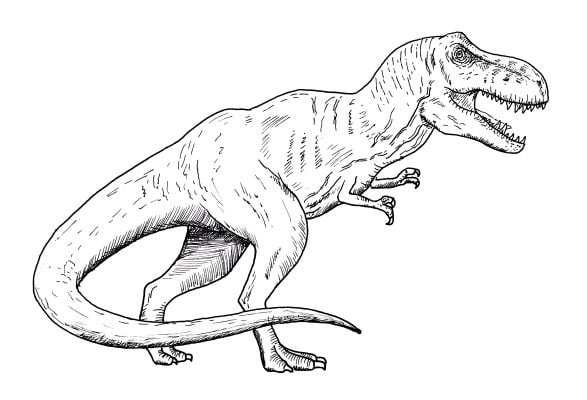
Essay Writing Guide – Different Kinds of Evidence
The definition of evidence that we’ve given is quite broad. In essence, any kind of facts or information can be regarded as evidence. The thing to make note of is that not all evidence is good evidence! What determines whether evidence is good or bad will depend on the subject you’re writing an essay for. This is because different academic disciplines, such as History and English Literature, care more about different types of evidence. Let’s take a look at different kinds of evidence now.
- Sciences such as Physics, Biology, Chemistry and Psychology, value peer-reviewed results of scientific studies.This means that, when making scientific arguments, you need to find results from well-received studies to support your argument.
- In contrast, History accepts a wider range of kinds of evidence. Historical statistics are welcome, but historical interpretation is also important.Strong theories written by historians can be used to support your own argument.
- In a subject such as English Literature, evidence will usually come in the form of quotations. For example, you might be asked to discuss the themes of a play.
To support your argument, you should find relevant quotations from the play. Like History, interpretations are also accepted as evidence. Try to find writers in the field of literary criticism which present theories about the play, book, or poem that you’re writing about.
Essay Writing Guide – How to Use Evidence in an Essay
When writing an essay, it is essential that you provide evidence. As we’ve discussed, evidence takes many forms. Make sure your type of evidence is appropriate for the subject you’re writing about.
So, if you’re writing a Psychology essay, don’t fill it with historical interpretation. Hard facts are necessary to sell your hypothesis in a scientific essay. Likewise, don’t bring hard statistics into an English Literature essay. This subject is all about interpretation, and so scientific studies won’t be particularly useful.
Evidence is always used to support a point that you’re trying to make.
- So, you make your point first. This is the claim of your argument: “Dinosaurs walked the earth tens of millions of years ago.”
- Once you’ve made your point, move on to your evidence: “Fossils found in Central America show that creatures used to live there.”
- Then you need to link the evidence back to your point by explaining it: “We can use radiocarbon dating to estimate how old the fossils are. Some of these fossils are over a hundred million years old.”

Essay Writing Guide – Key Phrases for Introducing Evidence
When incorporating evidence into an essay, you need to make sure it flows well. Try using some of these key phrases in your essay to help you introduce your evidence:
“The evidence clearly reveals…” “Analysis of the data suggests…” “This graph shows that…” “As shown by the information…” “This claim is supported by several authors, including…” “There seems to be a consensus regarding this…” “Popular opinion supports this idea…” “Popular opinion does not support this idea…” “Most experts agree…” “According to this study, we can deduce that…” “Over many years, this interpretation has developed…”
Essay Writing Guide – Key Phrases for Explaining Evidence
Once you’ve given your evidence, you need to be able explain it. Try using these phrases when explaining evidence in your essay:
“This means that…” “This evidence supports the claim that…” “This evidence supports this proposition because…” “It’s clear then, that this argument is supported by the evidence. This is because…” “If this evidence is true, then…” “This interpretation clearly supports the view that…” “This evidence suggests that…”
Essay Writing Guide – Key Phrases for Linking Evidence
Finally, you need to link your proposition, evidence, and explanation back to your main argument. Here are some phrases you can use to do this:
“Therefore, this analysis supports the central thesis of this essay…” “If followed to its logical conclusion, then this claim plays in favour of this essay’s core argument…” “The evidence and analysis presented here shows that…” “Due to this, it seems plausible that…” “In summary, it is shown that…” “While there are still many other ideas to consider, this proposition alone supports the view that…”
Essay Writing Guide – Key Phrases for Opposing Evidence
While most of the evidence you provide will support your argument, some essays will require you to examine counter-examples and evidence which opposes your central idea. So, make sure you clearly show that this evidence doesn’t damage your argument with the following phrases:
“While this evidence appears compelling, it doesn’t apply to these circumstances because…” “This counter-argument fails to acknowledge the following points: …” “While this is a popular counter-argument, it isn’t relevant to the focus of this essay, and therefore will not be discussed further.” “This claim relies on the premise that _____. The focus now will be to demonstrate that this premise is false.” “While this data appears to contradict the argument of this essay, this isn’t the case because…”
Essay Writing Guide – Key Phrases for Moving on to the Next Point
Eventually, you’ll need to move on to your next point. Here are some key phrases you can use to move from one point to another so that your essay flows better:
“Now that this claim has been suitably supported, the focus needs to shift to…” “The truth of this proposition has been clarified. Therefore, it is now appropriate to move to the next key argument in this essay: …” “This conclusion naturally leads to the next claim that…” “While this is compelling evidence, it is still not enough to logically reach the conclusion of this argument. It’s important to now discuss…” “While this theme is prominent in the text, others must also be considered, such as…” (Most relevant for English Literature essays)
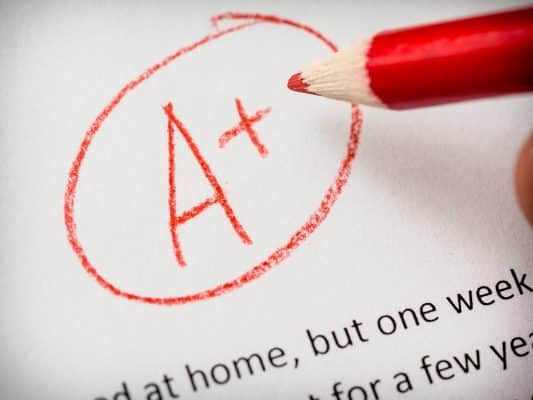
Essay Writing Guide – Handy Phrases for Discussing Evidence
Finally, here are a few phrases that you can make use of to flesh out your arguments so that they read better:
“According to…” “Also…” “As well as…” “Based on…” “Clearly…” “Closely…” “Confirmed by…” “Evidently…” “For example…” “For instance…” “In addition…” “Therefore…” “This indicates that…” “This suggests…”
Essay Writing Guide – Conclusion
Whenever you make a new claim, support it with evidence. Evidence takes many different forms – find evidence that is appropriate to your subject or topic.
Start by introducing your argument. Then, give evidence. After that, explain your evidence. Finally, link your evidence back to your central argument.
Evidence is the fuel for your argument. Make sure you have enough of it to get you across the finish line!
Andy Bosworth
One thought on “ essay writing guide – using evidence in your arguments ”.
Clearly explained.
Leave a Reply Cancel reply
You must be logged in to post a comment.
This site uses Akismet to reduce spam. Learn how your comment data is processed .
- Free Aptitude Tests

- Privacy Overview
- Strictly Necessary Cookies
This website uses cookies so that we can provide you with the best user experience possible. Cookie information is stored in your browser and performs functions such as recognising you when you return to our website and helping our team to understand which sections of the website you find most interesting and useful.
Strictly Necessary Cookie should be enabled at all times so that we can save your preferences for cookie settings.
If you disable this cookie, we will not be able to save your preferences. This means that every time you visit this website you will need to enable or disable cookies again.
Developing Evidence-Based Arguments from Texts

About this Strategy Guide
This guide provides teachers with strategies for helping students understand the differences between persuasive writing and evidence-based argumentation. Students become familiar with the basic components of an argument and then develop their understanding by analyzing evidence-based arguments about texts. Students then generate evidence-based arguments of texts using a variety of resources. Links to related resources and additional classroom strategies are also provided.
Research Basis
Strategy in practice, related resources.
Hillocks (2010) contends that argument is “at the heart of critical thinking and academic discourse, the kind of writing students need to know for success in college” (p. 25). He points out that “many teachers begin to teach some version of argument with the writing of a thesis statement, [but] in reality, good argument begins with looking at the data that are likely to become the evidence in an argument and that give rise to a thesis statement or major claim” (p. 26). Students need an understanding of the components of argument and the process through which careful examination of textual evidence becomes the beginnings of a claim about text.
- Begin by helping students understand the differences between persuasive writing and evidence-based argumentation: persuasion and argument share the goal of asserting a claim and trying to convince a reader or audience of its validity, but persuasion relies on a broader range of possible support. While argumentation tends to focus on logic supported by verifiable examples and facts, persuasion can use unverifiable personal anecdotes and a more apparent emotional appeal to make its case. Additionally, in persuasion, the claim usually comes first; then the persuader builds a case to convince a particular audience to think or feel the same way. Evidence-based argument builds the case for its claim out of available evidence. Solid understanding of the material at hand, therefore, is necessary in order to argue effectively. This printable resource provides further examples of the differences between persuasive and argumentative writing.
- One way to help students see this distinction is to offer a topic and two stances on it: one persuasive and one argumentative. Trying to convince your friend to see a particular movie with you is likely persuasion. Sure, you may use some evidence from the movie to back up your claim, but you may also threaten to get upset with him or her if he or she refuses—or you may offer to buy the popcorn if he or she agrees to go. Making the argument for why a movie is better (or worse) than the book it’s based on would be more argumentative, relying on analysis of examples from both works to build a case. Consider using resources from the ReadWriteThink lesson plan Argument, Persuasion, or Propaganda: Analyzing World War II Posters
- The claim (that typically answers the question: “What do I think?”)
- The reasons (that typically answer the question: “Why do I think this?”)
- The evidence (that typically answers the question: “How do I know this is the case?”).
- Deepen students’ understanding of the components of argument by analyzing evidence-based arguments about texts. Project, for example, this essay on Gertrude in Hamlet and ask students to identify the claim, reasons, and evidence. Ask students to clarify what makes this kind of text an argument as opposed to persuasion. What might a persuasive take on the character of Gertrude sound like? (You may also wish to point out the absence of a counterargument in this example. Challenge students to offer one.)
- Point out that even though the claim comes first in the sample essay, the writer of the essay likely did not start there. Rather, he or she arrived at the claim as a result of careful reading of and thinking about the text. Share with students that evidence-based writing about texts always begins with close reading. See Close Reading of Literary Texts strategy guide for additional information.
- Guide students through the process of generating an evidence-based argument of a text by using the Designing an Evidence-based Argument Handout. Decide on an area of focus (such as the development of a particular character) and using a short text, jot down details or phrases related to that focus in the first space on the chart. After reading and some time for discussion of the character, have students look at the evidence and notice any patterns. Record these in the second space. Work with the students to narrow the patterns to a manageable list and re-read the text, this time looking for more instances of the pattern that you may have missed before you were looking for it. Add these references to the list.
- Use the evidence and patterns to formulate a claim in the last box. Point out to students that most texts can support multiple (sometimes even competing) claims, so they are not looking for the “one right thing” to say about the text, but they should strive to say something that has plenty of evidence to support it, but is not immediately self-evident. Claims can also be more or less complex, such as an outright claim (The character is X trait) as opposed to a complex claim (Although the character is X trait, he is also Y trait). For examples of development of a claim (a thesis is a type of claim), see the Developing a Thesis Handout for additional guidance on this point.
- Modeling Academic Writing Through Scholarly Article Presentations
- And I Quote
- Have students use the Evidence-Based Argument Checklist to revise and strengthen their writing.
More Ideas to Try
- This Strategy Guide focuses on making claims about text, with a focus on literary interpretation. The basic tenets of the guide, however, can apply to argumentation in multiple disciplines—e.g., a response to a Document-Based Question in social science, a lab report in science.
- For every argumentative claim that students develop for a text, have them try writing a persuasive claim about the text to continue building an understanding of their difference.
- After students have drafted an evidence-based argument, ask them to choose an alternative claim or a counterclaim to be sure their original claim is argumentative.
- Have students use the Evidence-Based Argument checklist to offer feedback to one another.
- Lesson Plans
- Professional Library
- Student Interactives
- Strategy Guides
Students prepare an already published scholarly article for presentation, with an emphasis on identification of the author's thesis and argument structure.
While drafting a literary analysis essay (or another type of argument) of their own, students work in pairs to investigate advice for writing conclusions and to analyze conclusions of sample essays. They then draft two conclusions for their essay, select one, and reflect on what they have learned through the process.
The Essay Map is an interactive graphic organizer that enables students to organize and outline their ideas for an informational, definitional, or descriptive essay.
- Print this resource
Explore Resources by Grade
- Kindergarten K
Have a language expert improve your writing
Run a free plagiarism check in 10 minutes, generate accurate citations for free.
- Knowledge Base
- How to write an essay outline | Guidelines & examples
How to Write an Essay Outline | Guidelines & Examples
Published on August 14, 2020 by Jack Caulfield . Revised on July 23, 2023.
An essay outline is a way of planning the structure of your essay before you start writing. It involves writing quick summary sentences or phrases for every point you will cover in each paragraph , giving you a picture of how your argument will unfold.
Instantly correct all language mistakes in your text
Upload your document to correct all your mistakes in minutes

Table of contents
Organizing your material, presentation of the outline, examples of essay outlines, other interesting articles, frequently asked questions about essay outlines.
At the stage where you’re writing an essay outline, your ideas are probably still not fully formed. You should know your topic and have already done some preliminary research to find relevant sources , but now you need to shape your ideas into a structured argument.
Creating categories
Look over any information, quotes and ideas you’ve noted down from your research and consider the central point you want to make in the essay—this will be the basis of your thesis statement . Once you have an idea of your overall argument, you can begin to organize your material in a way that serves that argument.
Try to arrange your material into categories related to different aspects of your argument. If you’re writing about a literary text, you might group your ideas into themes; in a history essay, it might be several key trends or turning points from the period you’re discussing.
Three main themes or subjects is a common structure for essays. Depending on the length of the essay, you could split the themes into three body paragraphs, or three longer sections with several paragraphs covering each theme.
As you create the outline, look critically at your categories and points: Are any of them irrelevant or redundant? Make sure every topic you cover is clearly related to your thesis statement.
Order of information
When you have your material organized into several categories, consider what order they should appear in.
Your essay will always begin and end with an introduction and conclusion , but the organization of the body is up to you.
Consider these questions to order your material:
- Is there an obvious starting point for your argument?
- Is there one subject that provides an easy transition into another?
- Do some points need to be set up by discussing other points first?
Receive feedback on language, structure, and formatting
Professional editors proofread and edit your paper by focusing on:
- Academic style
- Vague sentences
- Style consistency
See an example

Within each paragraph, you’ll discuss a single idea related to your overall topic or argument, using several points of evidence or analysis to do so.
In your outline, you present these points as a few short numbered sentences or phrases.They can be split into sub-points when more detail is needed.
The template below shows how you might structure an outline for a five-paragraph essay.
- Thesis statement
- First piece of evidence
- Second piece of evidence
- Summary/synthesis
- Importance of topic
- Strong closing statement
You can choose whether to write your outline in full sentences or short phrases. Be consistent in your choice; don’t randomly write some points as full sentences and others as short phrases.
Examples of outlines for different types of essays are presented below: an argumentative, expository, and literary analysis essay.
Argumentative essay outline
This outline is for a short argumentative essay evaluating the internet’s impact on education. It uses short phrases to summarize each point.
Its body is split into three paragraphs, each presenting arguments about a different aspect of the internet’s effects on education.
- Importance of the internet
- Concerns about internet use
- Thesis statement: Internet use a net positive
- Data exploring this effect
- Analysis indicating it is overstated
- Students’ reading levels over time
- Why this data is questionable
- Video media
- Interactive media
- Speed and simplicity of online research
- Questions about reliability (transitioning into next topic)
- Evidence indicating its ubiquity
- Claims that it discourages engagement with academic writing
- Evidence that Wikipedia warns students not to cite it
- Argument that it introduces students to citation
- Summary of key points
- Value of digital education for students
- Need for optimism to embrace advantages of the internet
Expository essay outline
This is the outline for an expository essay describing how the invention of the printing press affected life and politics in Europe.
The paragraphs are still summarized in short phrases here, but individual points are described with full sentences.
- Claim that the printing press marks the end of the Middle Ages.
- Provide background on the low levels of literacy before the printing press.
- Present the thesis statement: The invention of the printing press increased circulation of information in Europe, paving the way for the Reformation.
- Discuss the very high levels of illiteracy in medieval Europe.
- Describe how literacy and thus knowledge and education were mainly the domain of religious and political elites.
- Indicate how this discouraged political and religious change.
- Describe the invention of the printing press in 1440 by Johannes Gutenberg.
- Show the implications of the new technology for book production.
- Describe the rapid spread of the technology and the printing of the Gutenberg Bible.
- Link to the Reformation.
- Discuss the trend for translating the Bible into vernacular languages during the years following the printing press’s invention.
- Describe Luther’s own translation of the Bible during the Reformation.
- Sketch out the large-scale effects the Reformation would have on religion and politics.
- Summarize the history described.
- Stress the significance of the printing press to the events of this period.
Literary analysis essay outline
The literary analysis essay outlined below discusses the role of theater in Jane Austen’s novel Mansfield Park .
The body of the essay is divided into three different themes, each of which is explored through examples from the book.
- Describe the theatricality of Austen’s works
- Outline the role theater plays in Mansfield Park
- Introduce the research question : How does Austen use theater to express the characters’ morality in Mansfield Park ?
- Discuss Austen’s depiction of the performance at the end of the first volume
- Discuss how Sir Bertram reacts to the acting scheme
- Introduce Austen’s use of stage direction–like details during dialogue
- Explore how these are deployed to show the characters’ self-absorption
- Discuss Austen’s description of Maria and Julia’s relationship as polite but affectionless
- Compare Mrs. Norris’s self-conceit as charitable despite her idleness
- Summarize the three themes: The acting scheme, stage directions, and the performance of morals
- Answer the research question
- Indicate areas for further study
If you want to know more about AI tools , college essays , or fallacies make sure to check out some of our other articles with explanations and examples or go directly to our tools!
- Ad hominem fallacy
- Post hoc fallacy
- Appeal to authority fallacy
- False cause fallacy
- Sunk cost fallacy
College essays
- Choosing Essay Topic
- Write a College Essay
- Write a Diversity Essay
- College Essay Format & Structure
- Comparing and Contrasting in an Essay
(AI) Tools
- Grammar Checker
- Paraphrasing Tool
- Text Summarizer
- AI Detector
- Plagiarism Checker
- Citation Generator
Prevent plagiarism. Run a free check.
You will sometimes be asked to hand in an essay outline before you start writing your essay . Your supervisor wants to see that you have a clear idea of your structure so that writing will go smoothly.
Even when you do not have to hand it in, writing an essay outline is an important part of the writing process . It’s a good idea to write one (as informally as you like) to clarify your structure for yourself whenever you are working on an essay.
If you have to hand in your essay outline , you may be given specific guidelines stating whether you have to use full sentences. If you’re not sure, ask your supervisor.
When writing an essay outline for yourself, the choice is yours. Some students find it helpful to write out their ideas in full sentences, while others prefer to summarize them in short phrases.
You should try to follow your outline as you write your essay . However, if your ideas change or it becomes clear that your structure could be better, it’s okay to depart from your essay outline . Just make sure you know why you’re doing so.
Cite this Scribbr article
If you want to cite this source, you can copy and paste the citation or click the “Cite this Scribbr article” button to automatically add the citation to our free Citation Generator.
Caulfield, J. (2023, July 23). How to Write an Essay Outline | Guidelines & Examples. Scribbr. Retrieved August 29, 2024, from https://www.scribbr.com/academic-essay/essay-outline/
Is this article helpful?

Jack Caulfield
Other students also liked, how to create a structured research paper outline | example, a step-by-step guide to the writing process, how to write an argumentative essay | examples & tips, get unlimited documents corrected.
✔ Free APA citation check included ✔ Unlimited document corrections ✔ Specialized in correcting academic texts
Welcome to the new OASIS website! We have academic skills, library skills, math and statistics support, and writing resources all together in one new home.

- Walden University
- Faculty Portal
Using Evidence: Analysis
Beyond introducing and integrating your paraphrases and quotations, you also need to analyze the evidence in your paragraphs. Analysis is your opportunity to contextualize and explain the evidence for your reader. Your analysis might tell the reader why the evidence is important, what it means, or how it connects to other ideas in your writing.
Note that analysis often leads to synthesis , an extension and more complicated form of analysis. See our synthesis page for more information.
Example 1 of Analysis
Without analysis.
Embryonic stem cell research uses the stem cells from an embryo, causing much ethical debate in the scientific and political communities (Robinson, 2011). "Politicians don't know science" (James, 2010, p. 24). Academic discussion of both should continue (Robinson, 2011).
With Analysis (Added in Bold)
Embryonic stem cell research uses the stem cells from an embryo, causing much ethical debate in the scientific and political communities (Robinson, 2011). However, many politicians use the issue to stir up unnecessary emotion on both sides of the issues. James (2010) explained that "politicians don't know science," (p. 24) so scientists should not be listening to politics. Instead, Robinson (2011) suggested that academic discussion of both embryonic and adult stem cell research should continue in order for scientists to best utilize their resources while being mindful of ethical challenges.
Note that in the first example, the reader cannot know how the quotation fits into the paragraph. Also, note that the word both was unclear. In the revision, however, that the writer clearly (a) explained the quotations as well as the source material, (b) introduced the information sufficiently, and (c) integrated the ideas into the paragraph.
Example 2 of Analysis
Trow (1939) measured the effects of emotional responses on learning and found that student memorization dropped greatly with the introduction of a clock. Errors increased even more when intellectual inferiority regarding grades became a factor (Trow, 1939). The group that was allowed to learn free of restrictions from grades and time limits performed better on all tasks (Trow, 1939).
In this example, the author has successfully paraphrased the key findings from a study. However, there is no conclusion being drawn about those findings. Readers have a difficult time processing the evidence without some sort of ending explanation, an answer to the question so what? So what about this study? Why does it even matter?
Trow (1939) measured the effects of emotional responses on learning and found that student memorization dropped greatly with the introduction of a clock. Errors increased even more when intellectual inferiority regarding grades became a factor (Trow, 1939). The group that was allowed to learn free of restrictions from grades and time limits performed better on all tasks (Trow, 1939). Therefore, negative learning environments and students' emotional reactions can indeed hinder achievement.
Here the meaning becomes clear. The study’s findings support the claim the reader is making: that school environment affects achievement.
Analysis Video Playlist
Note that these videos were created while APA 6 was the style guide edition in use. There may be some examples of writing that have not been updated to APA 7 guidelines.

Related Resources
Didn't find what you need? Email us at [email protected] .
- Previous Page: Quotation
- Next Page: Synthesis
- Office of Student Disability Services
Walden Resources
Departments.
- Academic Residencies
- Academic Skills
- Career Planning and Development
- Customer Care Team
- Field Experience
- Military Services
- Student Success Advising
- Writing Skills
Centers and Offices
- Center for Social Change
- Office of Academic Support and Instructional Services
- Office of Degree Acceleration
- Office of Research and Doctoral Services
- Office of Student Affairs
Student Resources
- Doctoral Writing Assessment
- Form & Style Review
- Quick Answers
- ScholarWorks
- SKIL Courses and Workshops
- Walden Bookstore
- Walden Catalog & Student Handbook
- Student Safety/Title IX
- Legal & Consumer Information
- Website Terms and Conditions
- Cookie Policy
- Accessibility
- Accreditation
- State Authorization
- Net Price Calculator
- Cost of Attendance
- Contact Walden
Walden University is a member of Adtalem Global Education, Inc. www.adtalem.com Walden University is certified to operate by SCHEV © 2024 Walden University LLC. All rights reserved.

- Skip to main content
Join All-Access Reading…Doors Are Open! Click Here
- All-Access Login
- Freebie Library
- Search this website
Teaching with Jennifer Findley
Upper Elementary Teaching Blog
Text Evidence Activities and Strategies – Tips for Teaching Students to Find Text Evidence
Teaching students to answer constructed response questions correctly and with sufficient text evidence can be quite the feat. A good starting point is to use an acronym such as RACE to help guide the students. But, that is just one part of instruction. The most difficult part is teaching students to find text evidence and then cite it appropriately to fully support their answer or analysis. This post will share my recommended text evidence activities, tips, and strategies (including several free resources).
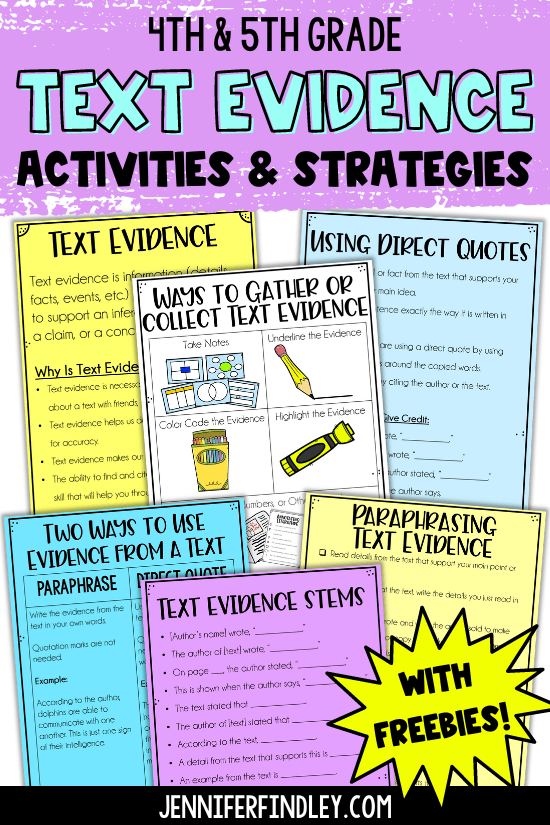
What is Text Evidence?
Table of Contents
Text evidence is information (facts, details, quotes) from a fiction or nonfiction text that is used to support an inference, claim, opinion, or answer.
Students are often required to include text evidence to support their answers to constructed response questions and extended essays. Text evidence is also important to use when having discussions about texts. It helps back up the student’s thoughts on the text they are reading.
Tips Teaching Students to Find Text Evidence
1. introduce with read alouds and simple activities, teaching text evidence through read alouds.
I like to start introducing the skill of collecting text evidence early on in the year with relevant read alouds.
When reading a picture book or chapter book, give your students a focus question or task and then have them collect evidence by writing it on post-it notes throughout the read aloud.
Here are some examples that are easily adaptable to most read alouds.
Example Prompts for First Reads
- Find evidence of a theme used by the author to teach the reader a lesson.
- Find evidence of the text structure used by the author.
- Find evidence of the character traits displayed by the main character(s).
- Find evidence of the author’s opinion/viewpoint/perspective of the topic.
- Find evidence of the point of view/perspective used to tell the story.
Example Prompts for Second Reads
- Find evidence that the main character is XYZ (sad, greedy, brave, honest, etc.).
- Find evidence that the setting is XYZ (important to the story, the desert, a school, etc.).
- Find evidence that the animal is XYZ (beneficial to humans/ecosystem, harmful, endangered, etc).
This can be a new read aloud or even a familiar read aloud. Familiar read alouds are excellent for digging back into a text to specifically look for evidence to support a point, conclusion, or inference.
After gathering the text evidence, we discuss the evidence we found with partners and then as a class. You could keep this simple with just a class discussion or elevate it by listing the evidence on a chart, ranking the evidence from strongest to weakest, or having the students record their thoughts in a constructed response. For more tips on helping students with constructed response reading questions, click here.
Teaching Text Evidence Through Simple Activities
After introducing the skill of finding relevant text evidence with read alouds, I like to use another text evidence activity that has the students reading texts and finding evidence to support one inference. For this, I use my “What’s the Text Evidence?” reading activities .
To complete the activities , the students will read texts (eight texts per set). They will use text evidence to determine the animal, career, or location (depending on the set) being described. They will then underline or summarize the text evidence that helped them infer.
This activity is a perfect next step because it is both non-threatening and engaging for students.
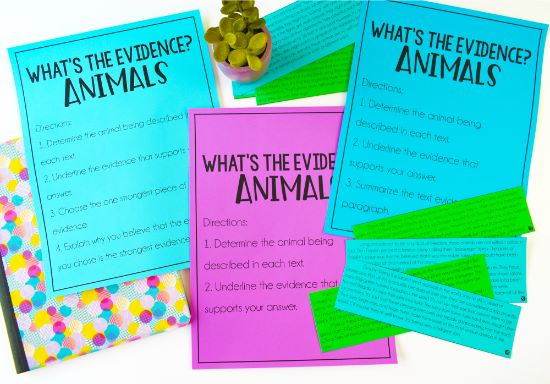
2. Teach the Importance of Finding Textual Evidence
I also really want to make sure my student understand why they are searching and citing evidence. We discuss how evidence helps in a few ways:
- Text evidence is necessary to support discussions about a text with friends, classmates, or teachers.
- Providing text evidence helps us double check our own answers for accuracy.
- Providing text evidence makes our answers valid and reliable.
- The ability to find and cite text evidence is a life-long skill that will help students throughout school and in their career choice.
Notice how I don’t mention the state test. This is intentional. I want the students to see the purpose beyond a test.
We typically discuss this early on when introducing text evidence and I try and sprinkle it in as it comes up throughout the year. This keeps it from seeming like chore and unnecessary busy work.
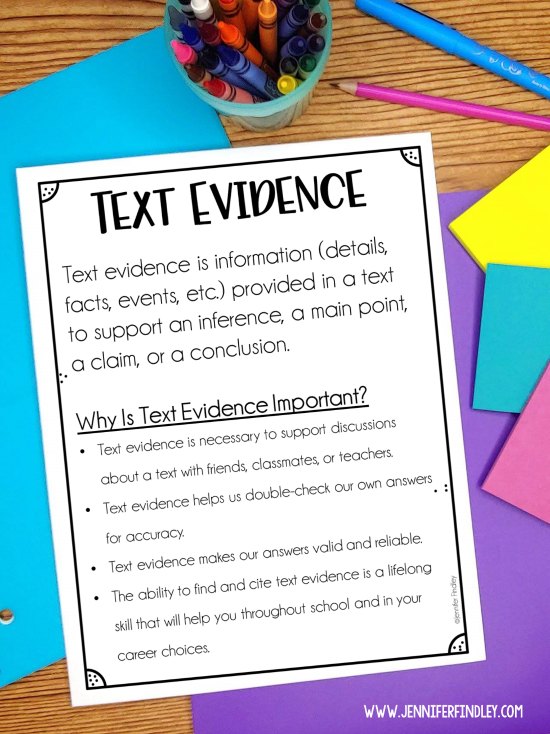
***Click here to grab the free printable shown (you can find it on page 2 of the PDF). You can use it to guide your instruction or to craft a text evidence anchor chart.
3. Require Text Evidence in Discussions
One easy way to help your students master text evidence is by requiring they use it in discussions. This can be whole class discussions or peer-to-peer discussions.
A very simple way to do this is using the stem:
I know…because…
Post the stem and remind your students to use this to defend and back up their answers.
As your students become comfortable with using evidence to back up their answers, add more sentence stems or sentence starters for your students to choose from.
However, I like to begin with the easiest one possible for my students while they are getting comfortable with including text evidence in their text discussions. More about the other sentence stems you can offer your students later in this post.
A great activity for discussing text evidence is my “Who is the Speaker?” Printables.
- To complete the printables, the students will read a half-page text from an unknown speaker/narrator. The students will use text evidence to determine who the speaker of the text is. They will also underline and summarize the text evidence that supports their answers.
- I like to partner my students up and give each one a different printable. They have to convince their partner of who the speaker of their text is by using text evidence.
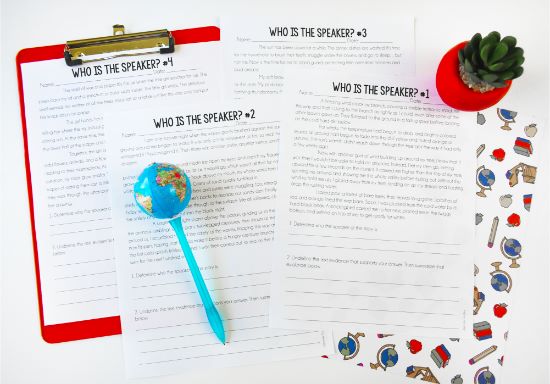
4. Teach Students Multiple Ways of Gathering Evidence
Another practical real-world skill involving evidence is modeling, teaching, and practicing multiple ways of gathering evidence.
Here are some examples:
- Taking notes
- Underlining
- Color coding —> For ready-to-use text evidence activities with color coding embedded, click here.
- Highlighting
- Using marks, numbers, or other symbols
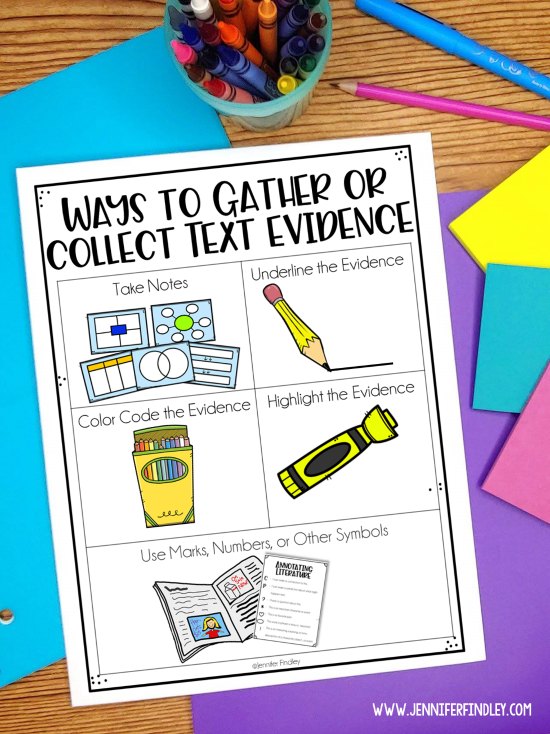
***Click here to grab a printable version of the chart shown to help your students learn the ways they can gather or collect text evidence. You can find it on page 3 of the PDF.
After introducing and modeling the different ways to gather evidence, my students then chose the way that works best for them.
Also, you want to ensure they have practice finding text evidence while:
- Listening to a read aloud
- Reading a book
- Researching on the internet
To provide direct and explicit practice in this area, I use two resources:
1. Find the Evidence Printables
- To complete the text evidence printables, the students will read a grade level text (mix of fiction and nonfiction). They will then read to see what evidence they are looking for. They will reread the text, find required text evidence, and underline/highlight/or record it.
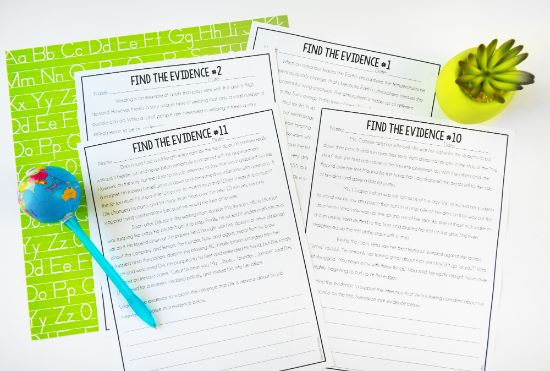
2. Find the Evidence Task Cards
- This is a similar activity but in task card format. To complete the task cards, the students will read the directions to see what specific text evidence they are looking for. They will then read the text and find that text evidence (again in whatever method of gathering you recommend or they choose). Finally, they will summarize the evidence.
Want to try these for FREE? Enter your information below to have 11 unique Text Evidence Task Cards sent to your email!
FREE Find the Evidence Task Cards
Join my email list to get the Find the Evidence Task Cards for FREE!
Success! Now check your email to grab your task cards!
There was an error submitting your subscription. Please try again.
Explicitly Teach Students How to Cite Text Evidence
1. teach students to paraphrase evidence and use direct quotes.
Make sure that you explicitly teach the different ways to cite evidence from the text: quoting and paraphrasing. I do teach both types but, honestly, I prefer to have my students paraphrase the evidence in their own words. This keeps them from plagiarizing and having an answer that is not their original thoughts. With that being said, quoting directly from a text may be a requirement in your state, so I recommend looking into that.
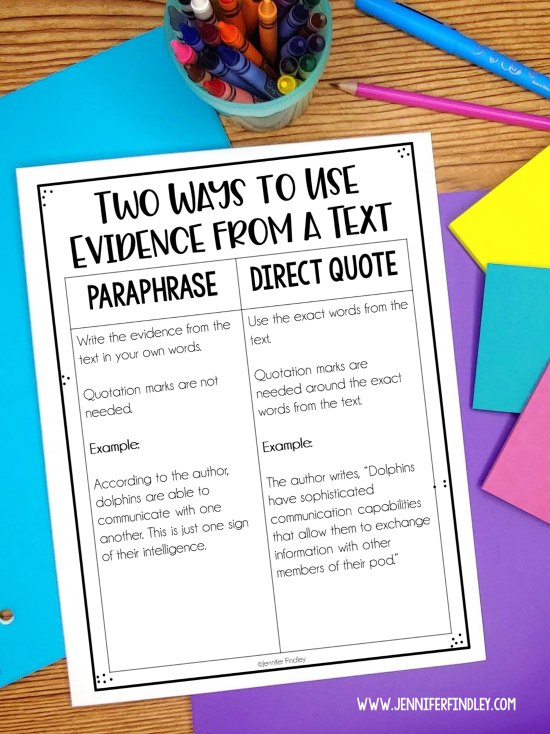
***Click here to download the printables I use to guide my instruction on the different ways to cite text evidence. These can be found on pages 4-6 of the free download.
The Find the Evidence task cards mentioned in the above section work perfectly for practicing citing text evidence because the students’ jobs are to only find the relevant evidence and then summarize it.

2. Provide Sentence Stems
Once your students have become more comfortable with pulling text evidence into their writing and discussions, it is time to provide them with more advanced options for bringing in that evidence.
Click here to download the printable I give my students (and the bookmark version). These are on pages 7 and 8 of the PDF.

3. Teach the Power of 3 (Three Pieces of Text Evidence)
I teach my students the power of 3. This means that they try to provide three pieces of evidence to support their answers. We do talk about how sometimes three pieces of evidence may not be available. However, teaching the power of 3 and that the more evidence you provide, the more difficult it is to refute the answer, keeps students searching for more relevant evidence to use.
**Click here to download the graphic organizer (and another option) shown that will help your students organize their three pieces of evidence. The organizers can be found on pages 9 and 10 of the PDF.
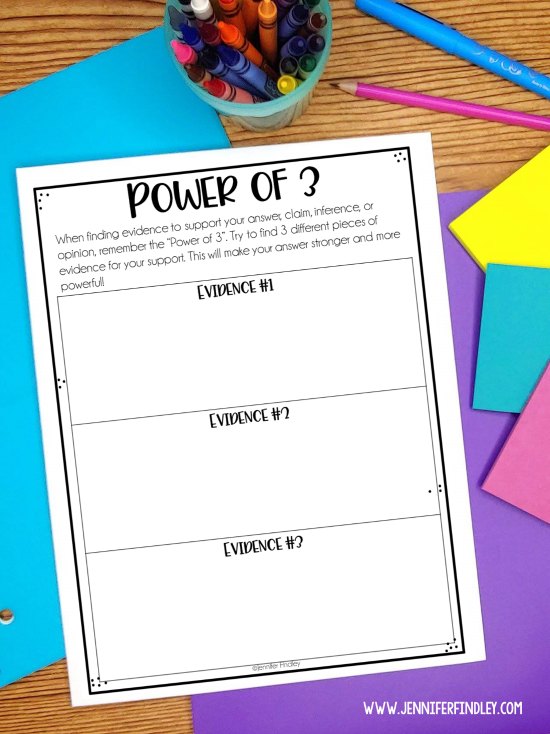
Teaching Students to Explain Text Evidence
The final step is teaching students to explain their text evidence. This is by far the trickiest skill in the entire text evidence process. It’s both difficult to teach and tricky for students to master. This is one reason I recommend waiting until your students have mastered the above skills before even tackling this part.
Here are some strategies I use to help my student understand what it means to explain their evidence, why it is important, and to keep them from just restating their evidence.
1. First, I introduce explaining evidence using a detective analogy. We talk about how detectives collect all of the important and relevant evidence for a case. But they don’t just plop the evidence down on their bosses’ desks. They have to explain how the evidence they collected proves his or her case. You could also use a lawyer/judge analogy for this as well.
2. Next, I provide simple sentence stems to both help my students explain their evidence and reinforce the importance of explaining it to begin with. I do a lot of modeling with this step. It is definitely not a “give them the list and forget about it” strategy. The stems are also very basic and simple for a reason. I want them to understand the purpose of explaining evidence and the difference between explaining it and just restating it. Eventually, the students will move away from this and use varied language (though sometimes this does require more modeling and support from me).
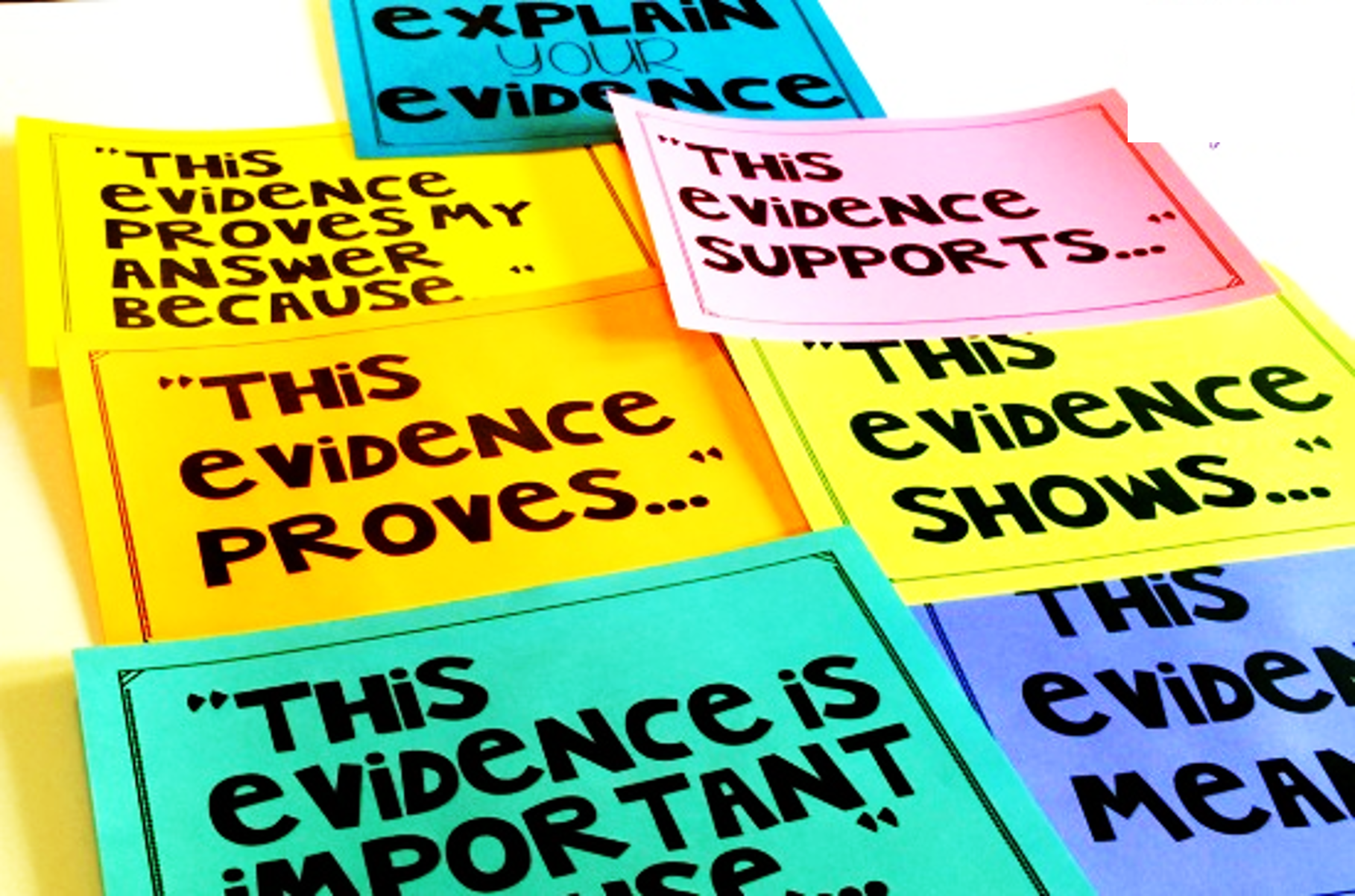
*** Click here to grab the free set of sentence stems posters to help your students explain their evidence.
One text evidence activity that really helps with the skill of explaining text evidence is my “What Does the Text Evidence Reveal?” Task Cards .
For this activity, the students will read a text (mix of fiction and nonfiction). They will analyze the underlined evidence. They will then answer the question, which requires them to write about what the evidence reveals or shows them. This activity is perfect because it allows them to focus explicitly on explaining the text evidence and what it shows.
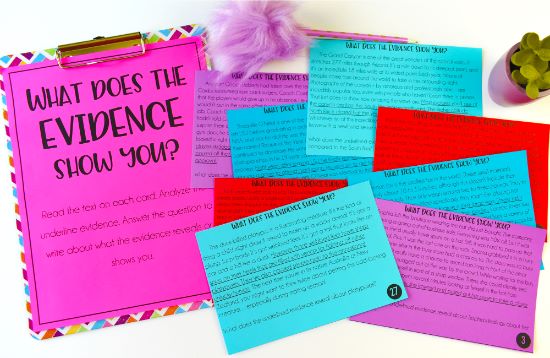
Want ALL of the Text Evidence Activities Featured on this Post?
Each activity is linked in the section that includes it, but I wanted to make sure that you saw that I have a money saving bundle of all of my text evidence activities. Click here or on the image below to check it out and read more.
Shop This Post
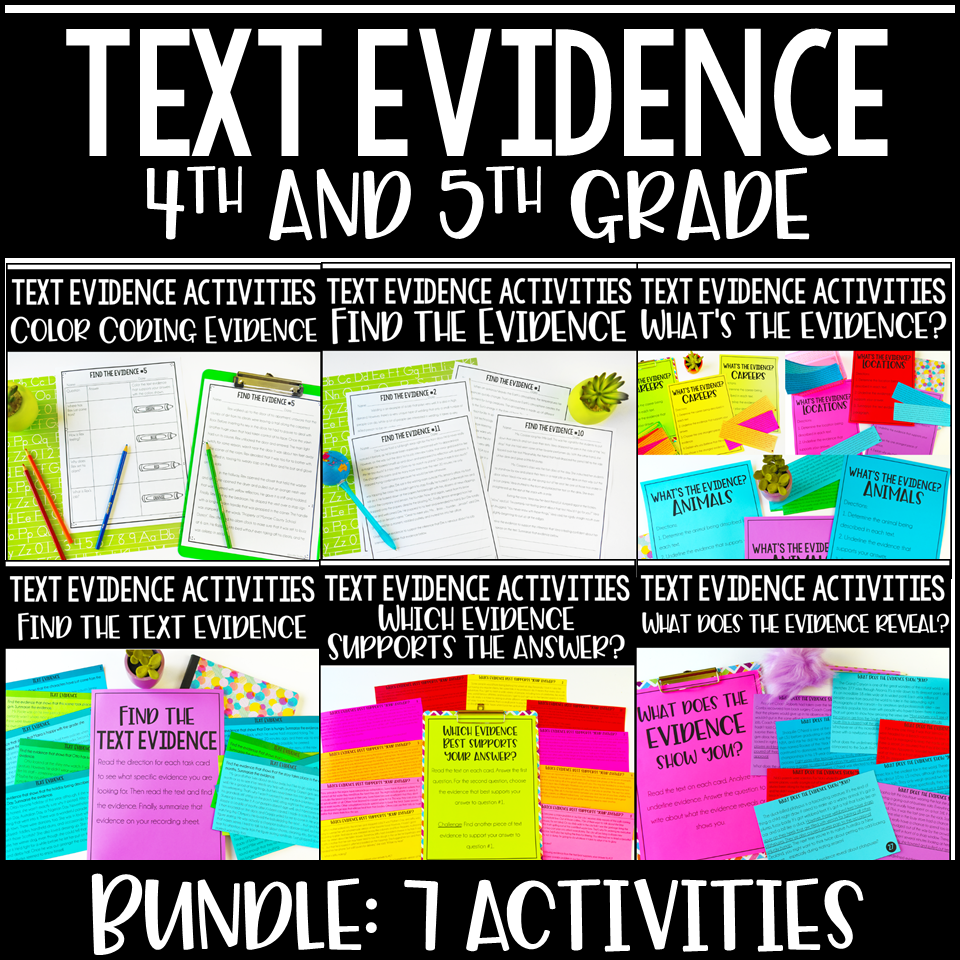
Text Evidence Activities | Citing Text Evidence
Share the knowledge, reader interactions.
April 18, 2020 at 11:09 am
Thank you so much!!!
June 17, 2020 at 2:50 pm
Hi Jennifer,
I love your activities and strategies to help students cite evidence from the text. I am excited to try some of them with my students because I haven’t found a method that is as effective as I would like it to be. I use RACE most often because it is easy for them to remember, but I felt like it isn’t enough. The ways you expanded on that method are great and I will definitely be using them.
One question I have that I’m hoping you have some advice or guidance on is about getting students to realize the importance of citing evidence. I frequently find myself in situations with students where they are either citing the wrong information because they don’t look back through the text or they don’t think they need to justify their thinking. I was wondering if this is something you face or have faced and if you have any suggestions for how to overcome it.
Using the methods you talk about here are definitely going to help with their motivation and engagement, but I am worried that I will still have similar problems. Any help would be greatly appreciated!
August 13, 2020 at 2:04 am
thank you veru much for he free material , for sure I will use it on my online classes. thanks you are really kind
July 26, 2023 at 11:00 pm
I am so overjoyed with excitement to find such overwhelming amount of strategies and hands on activities I can use starting day one of school. Where have you been all summer! I’m glad I still have a few days left of freedom, but I am going to spend them printing and organizing these great ideas. Thank you
Leave a Comment Cancel reply
Your email address will not be published. Required fields are marked *
Notify me of follow-up comments by email.
Notify me of new posts by email.
TEACHING READING JUST GOT EASIER WITH ALL-ACCESS
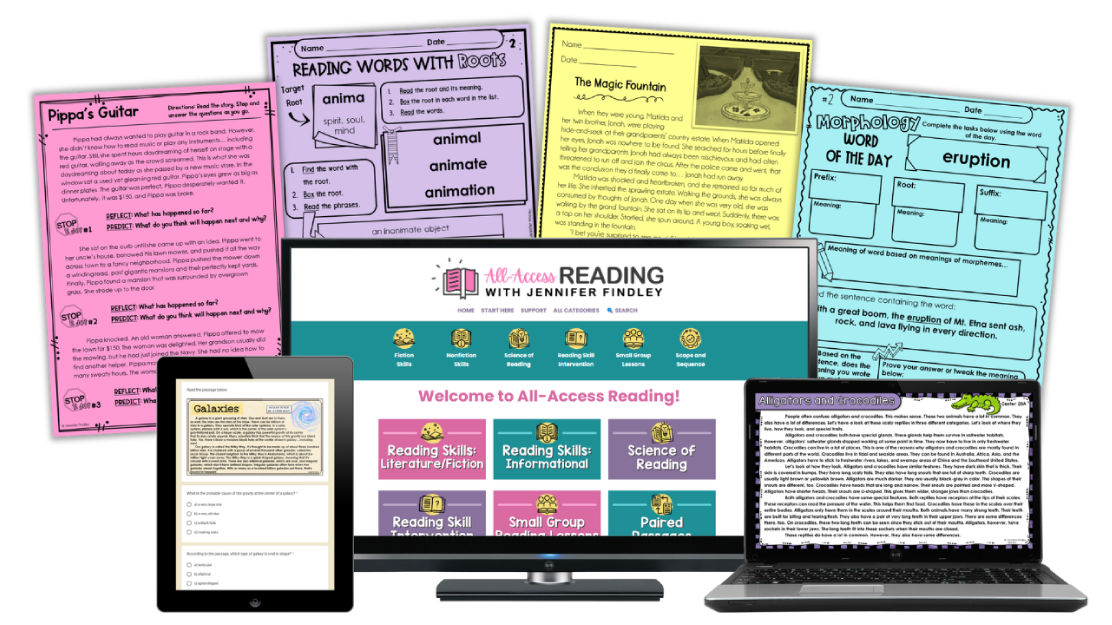
Join All-Access Reading to get immediate access to the reading resources you need to:
- teach your reading skills
- support and grow your readers
- engage your students
- prepare them for testing
- and so much more!
You may also love these freebies!
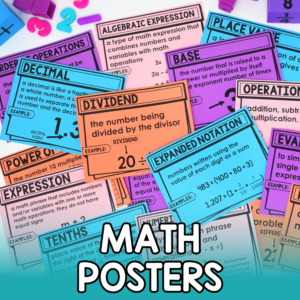
Math Posters
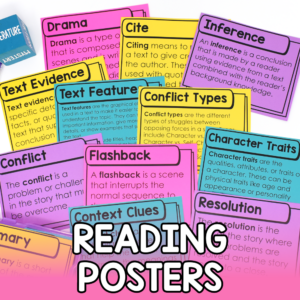
Reading Posters
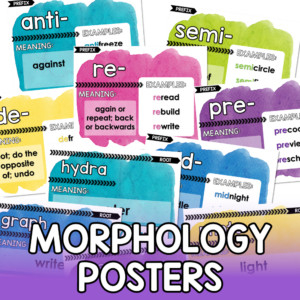
Morphology Posters
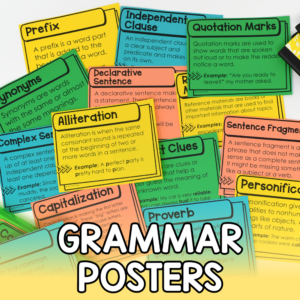
Grammar Posters

Welcome Friends!
I’m Jennifer Findley: a teacher, mother, and avid reader. I believe that with the right resources, mindset, and strategies, all students can achieve at high levels and learn to love learning. My goal is to provide resources and strategies to inspire you and help make this belief a reality for your students.
All Subjects
Argument Essay: Evidence
8 min read • june 18, 2024
Stephanie Kirk
We aren’t sure where it started, but many teachers use REHUGO to help students find evidence on the Argument FRQ . This acronym provides a quick check that can help you build logical evidence that supports your claim .
- R - Reading - Something you have read, fiction or nonfiction, that connects the given topic.
- E - Entertainment - A movie or song with dialogue or lyrics that present related ideas.
- H - History - An event, document, speech, or person from history that aligns with the given topic.
- U - Universal Truths - A common maxim or socially-accepted quote people tend to accept as truth.
- G - Government - A national or international current event or governmental situation related to the topic.
- O - Observations - Any cultural, technical, or societal trend that relates to the topic.
Suggested Guided Questions for the Argument FRQ
Now that you have a better understanding of the Argument FRQ’s expectations and scoring, let’s visit a sample prompt and add a few guided questions that you can use to help plan your own writings.
| In his book Canadian journalist Malcolm Gladwell (born 1963) writes: “To assume the best about another is the trait that has created modern society. Those occasions when our trusting nature gets violated are tragic. But the alternative—to abandon trust as a defense against predation and deception—is worse.”Write an essay that argues your position on the importance of . |
Guided Question 1: What does the prompt say? 📝
- Why do I do this? Understanding the concept or idea presented by the prompt is vital to planning a response that thoroughly addresses the prompt and stays on topic throughout. This is where you are going to BAT the PROMPT .
- Background : Gladwell asserts that society should trust each other in order to continue to be productive. Assuming the best about each other presents a better outcome than assuming the worst about each other.
- Advice : The new stable prompt wording does not give much advice, but you should revisit advice you learned in class or from us as Fiveable -- things like using Toulmin to plan your response and planning modes of development that help progress your reasoning.
- Task : Write an essay giving your position about the importance of trust. Specifically, is Gladwell right or wrong? And why? 🎥 Watch: AP Lang - Argumentation, Part I: It's a Trap!
Rhetorical Situation : When writing for AP Lang, it is important to consider the rhetorical situation and write in a manner that demonstrates an understanding of all elements of that situation.
- Context - the historical, social, and cultural movements in the time of the text
- Exigence - the urgency that leads to an action
- Purpose - the goal the speaker wants to achieve and the desired audience movement
- Persona - the “mask” shown to his/her audience

Guided Question 2: What do I think? 💡
Why do I do this? Taking a moment to brainstorm ideas can help organize thoughts and build an outline that you can revisit if you lose your train of thought in the stress of timed writing.
What does it look like? This might just be stream-of-consciousness in your head, cloud diagrams, or even bulleted notes on the side of your prompt, but it needs to end with a clear position statement you can use for your thesis statement . For example: Trust is important. It does suck to get betrayed though but having a positive outlook creates positive results. Thinking the worst makes people act negatively because they project in a way that leads toward the worst response. ⬇️
- Thesis Statement: Although some people believe humanity seems self-interested, a trusting nature enables individuals to focus on the positive and treat others with the respect that foster positive interrelationships.
Guided Question 3: What evidence can I use? 🤔
- Why do I do this? Revisit REHUGO and use Toulmin to plan your body paragraphs based on the thesis statement you came to when brainstorming ideas.
- Modes of Development: When writing, it is helpful to arrange the overall essay and its parts in a way that aligns with the purpose. Consider these basic modes and how you might use them in writing an argumentative essay.- Cause and Effect attempt to follow the chain of events and establish causation. The description brings imagery and details into a text so that it set up the tone and ensures the reader can follow the mood.- Classification allows the speaker to categorize things in a way that guides the reader to follow the line of reasoning.- Comparison , looking at the similarities and differences, helps to analyze the intricate details of a given topic. Because this describes differing elements, it may be structured by the element or by the characteristic.- Definition works to explain what something is or is not. By defining the subject being discussed, the speaker is able to control the thinking about that subject. Because this helps to clarify the topic, it is generally used in the introductory section of argumentation.- Exemplification is used when explaining the topic or situation by giving examples to help lead the audience to the desired conclusion.- Narration tells a story or gives an anecdote to help illustrate the point.- Process Analysis serves to explain the process by which something is done.
- What does it look like? I always use a version of the T-chart because one side is my evidence and the other side helps me consider multiple perspectives. You may not have an idea in all areas, and you may have multiple ideas in one area. Try to time yourself so that you get plenty of strong evidence without wasting too much time. | Supports 🏗️ | Thoughts 💭 | | --- | --- | | ~ R - Trust in Society by Cook points out that we only realize the importance of trust when there’s a breakdown.~ R - Essay “Importance of Trust” from class said that trust is not easy but it is what builds the foundation of a relationship and drives all actions between sides.~ E - The 2011 movie Trust shows that too much trust can get you hurt or killed.~ E - The media has so much bias it can’t be trusted… ~ H - Revolutionary War - trusted founding fathers and God’s position resulting in breaking free from Britain~ U - Trust - People should be trusted until proven otherwise~ G - A criminal escaped in our town and was on the loose; we trusted police to do their job rather than resort to vigilante justice~ G - Trust the president will have our best interests at heart -- most appear to have done that~ O - App-based dating - relies on trusting the person you meet online before meeting in person | > relationships between couples> trust in contractual agreements? Moral obligation for trust?> Counter?> Relied on trust and won with not much else to go ob> Ex, Parents, Teachers, Siblings > Trust helped keep us safe; job was well done when we were out of the way> Obvious exceptions; System of impeachment |
🎥 Watch: AP Lang - Review: Argument Body Paragraphs
PRO TIP: What if you have more evidence for the other side? Well, you haven’t started writing just yet, so it isn’t too late to go back and revise the thesis statement. Sometimes this happens in looking for evidence, and that’s perfectly okay. In fact, many times students will say they wrote an essay using evidence that went completely against what they felt in their head or heart just because they couldn’t put a logical argument on paper without getting too emotional. Know your audience, and build your argument.
Guided Question 4: How should I effectively organize my response? 📈
- Why do I do this? This step helps to outline the response so that your ideas are organized before you start writing. The general advice is to follow the structure of Classical Argumentation , but there is no rule saying that must be done to score well on the rubric. 💯
- What does it look like? One way of doing this would be to mark numbers by ideas tracked and written in the brainstorm, but some do take a moment to build an outline with topic sentences.
- Modes of Development: When writing, it is helpful to arrange the overall essay and its parts in a way that aligns with the purpose. Consider these basic modes and how you might use them in writing an argumentative essay.- Cause and Effect attempt to follow the chain of events and establish causation. The description brings imagery and details into a text so that it set up the tone and ensures the reader can follow the mood.- Classification allows the speaker to categorize things in a way that guides the reader to follow the line of reasoning.- Comparison , looking at the similarities and differences, helps to analyze the intricate details of a given topic. Because this describes differing elements, it may be structured by the element or by the characteristic.- Definition works to explain what something is or is not. By defining the subject being discussed, the speaker is able to control the thinking about that subject. Because this helps to clarify the topic, it is generally used in the introductory section of argumentation.- Exemplification is used when explaining the topic or situation by giving examples to help lead the audience to the desired conclusion.- Narration tells a story or gives an anecdote to help illustrate the point.- Process Analysis serves to explain the process by which something is done.
- Start by creating Toulmin Position Statements that can be used for topic sentences and then move into a writing plan. Here’s a sample for this prompt:
Sample Outline:
- Revised Thesis: Although some people believe trust must be earned, maintaining a trusting nature is important because it enables society to focus on positivity and create positive interrelationships that lead to positive outcomes.
- Universal truth
- Observation
- Entertainment - refute
- Conclude: When considering the value of trust in society, it is clear that the benefits of granting trust far outweigh the consequences of withholding it.
Key Terms to Review ( 35 )
© 2024 fiveable inc. all rights reserved., ap® and sat® are trademarks registered by the college board, which is not affiliated with, and does not endorse this website..
You are using an outdated browser and it's not supported. Please upgrade your browser to improve your experience.
- LOGIN FOR PROGRAM PARTICIPANTS
- PROGRAM SUPPORT
Informative Writing: Charting Topics, Subtopics, Claims, and Evidence
Description.
In this lesson, students continue their analysis of the article “The New Deal” to build their knowledge on this unit’s informative writing topic. Students review the topic and claim of the article before briefly discussing how to organize their reading notes. Then, students work in pairs or groups to identify and chart the subtopics and evidence presented in the article.
There may be cases when our downloadable resources contain hyperlinks to other websites. These hyperlinks lead to websites published or operated by third parties. UnboundEd and EngageNY are not responsible for the content, availability, or privacy policies of these websites.
- Writing Module, Unit 2, Lesson 4
- Short Response Rubric and Checklist, Writing Module, U2, Lesson 4
- Subtopics and Evidence Chart, Writing Module, U2, Lesson 4
Related Guides and Multimedia
Our professional learning resources include teaching guides, videos, and podcasts that build educators' knowledge of content related to the standards and their application in the classroom.
There are no related guides or videos. To see all our guides, please visit the Enhance Instruction section here .
myAU | AU Library | myWCL | Library Home | myLEAGLE Library Account

Pence Law Library Guides
Library Home | Research Guides | LEAGLE Catalog | E-Journals & Articles | Library Databases | Frequently Used Resources | Ask a Librarian
Exam Resources: Evidence
- Civil Procedure
- Constitutional Law
- Criminal Law
- Criminal Procedure
- Study Aids @ Pence
- How to Study
- Sample Exams
Case Briefs
Examples and Explanations
Audio Lectures

- << Previous: Criminal Procedure
- Next: Property >>
- Last Updated: Aug 23, 2024 9:54 AM
- URL: https://wcl.american.libguides.com/exams
- 0 Shopping Cart $ 0.00 -->

Want to learn more about law school tutoring with JD Advising? Attend our free tutoring information session on September 5th at 12:00 pm ET to get all your questions answered!
Learn the best strategies to succeed in law school in this free downloadable guide , written by our founder who graduated #1 in her class!
Overwhelmed in law school? We can help! Check out our law school tutoring and law school outlines – our top law school resources that are sure to get you back on track!
UBE Essay Frequency Chart
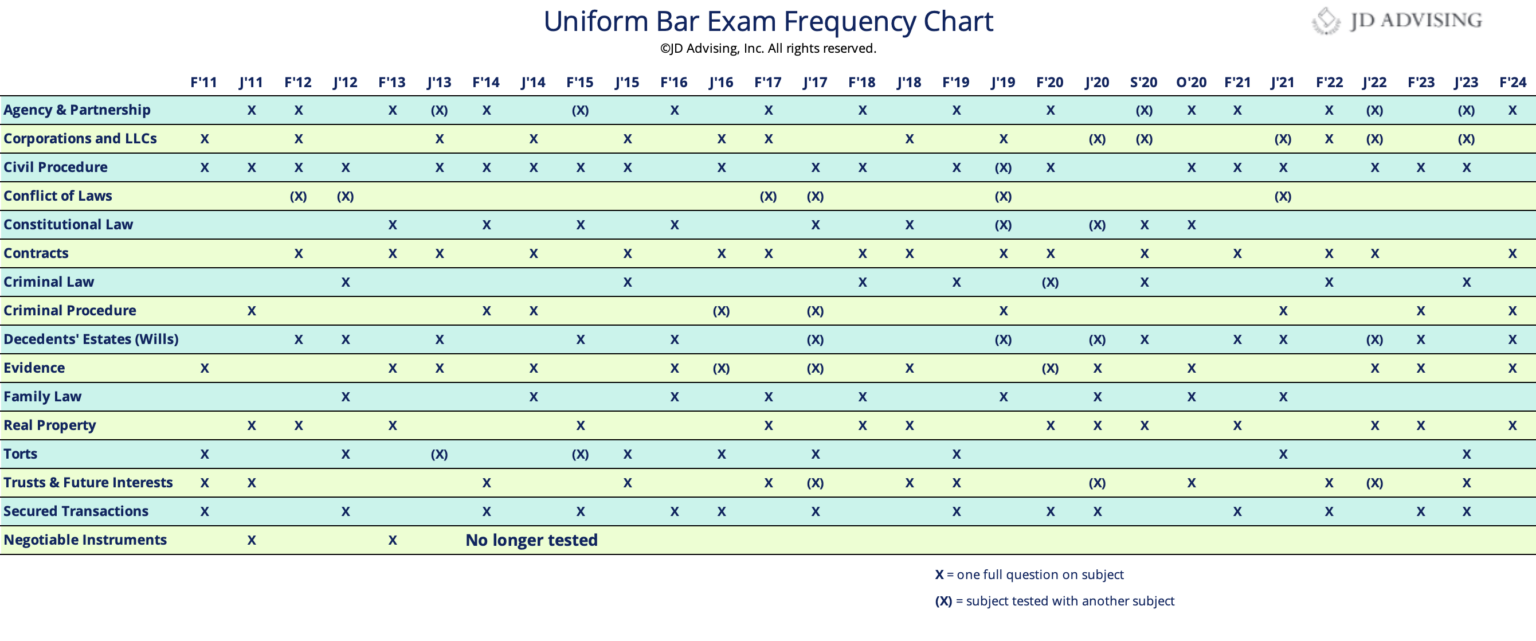
UBE Essay Frequency Chart: Which subjects are tested frequently on the Uniform Bar Exam (UBE)? To be the most efficient when you study, you will want to study the subjects that you are most likely to see. Below we reveal the highly tested subjects on both the Multistate Essay Exam (MEE) as well as the Multistate Bar Exam (MBE).
Note: As we explain below, even if you are taking the exam in a jurisdiction that is not a Uniform Bar Exam jurisdiction but that contains the MEE as a component, it is wiser to look at this UBE essay frequency chart than it is to look at an MEE frequency chart. (The UBE essay frequency chart is more indicative of what could be tested on your exam!)
Lastly, if you are interested in the MEE topics that have been tested most frequently, please review our free MEE guide for the highly tested topics and don’t miss out on our MEE One-Sheets . They are one of our most highly-rated products!
Which subjects are tested on the Uniform Bar Exam?
The Uniform Bar Exam is composed of the Multistate bar exam (MBE); the Multistate Performance Test (MPTs), which do not cover a specific area of law–rather, they test lawyerly skills; and also an essay portion, the multistate essay exam (MEE). Below are the tested subjects on the Multistate Bar Exam and the Multistate Essay Exam portion of the Uniform Bar Exam. To see how the MPTs have been tested, check out our MPT chart .
Subjects tested on the Essay Portion of the Uniform Bar Exam
For the essay portion, you will have six questions to answer in three hours (so 30 minutes/question). the Uniform Bar Exam tests the same subjects that the Multistate Essay Exam (MEE) tests. (The Multistate Essay Exam is a six-question exam used by Uniform Bar Exam states as well as other states that do not offer the Uniform Bar Exam.)
The National Conference of Bar Examiners lists the following subjects as potential areas of law:
- Business Associations (Agency and Partnership; Corporations and Limited Liability Companies),
- Civil Procedure,
- Conflict of Laws,
- Constitutional Law,
- Criminal Law and Procedure,
- Family Law,
- Real Property,
- Trusts and Estates (Decedents’ Estates; Trusts and Future Interests), and
- Uniform Commercial Code (Secured Transactions).
Six essays appear on the Uniform Bar Exam, chosen by the National Conference of Bar Examiners (NCBE). (Thus, while in the past, the NCBE has released 7-9 questions for jurisdictions that use the Multistate Essay Exam to choose from, the subjects that appear on the Uniform Bar Exam have always been the same. Further, beginning February 2014, the NCBE only wrote six questions for the Multistate Essay Exam, thus eliminating the choice by the jurisdiction about which essay topic to administer.) So we think this UBE frequency chart means more than an MEE frequency chart (but we do have an MEE frequency chart here if you want to check it out). We think it is wiser to look at this chart though!
So, as you can see from the chart above, the single most highly tested subject on the essay portion of the Uniform Bar Exam is Civil Procedure. We’ve also divided up the subjects so you can see the most highly-tested to least-tested subjects. Please click on the chart to open it in a new tab to make it bigger!
[Note the data below comes from the February 2011 bar exam to the most recent bar exam.]
Tier One: Highly Tested Subjects on the Uniform Bar Exam (In Order of Most-to-Least Tested)
- Civil Procedure (20 full essays plus 1 combined with another subject)
- Agency and Partnership (13 full essays plus 5 combined with another subject)
- Contracts (16 full essays)
- Real Property (14 full essays)
- Secured Transactions (14 full essays)
- Corporations and LLCs (10 full essays plus 5 combined with another subject)
- Evidence (11 full essays plus 3 combined with another subject)
- Decedents’ Estates (Wills) (10 full essays plus 4 combined with another subject)
- Trusts and Future Interests (10 full essays plus 3 combined with another subject)
- Constitutional Law (8 full essays plus 2 combined with another subject)
- Torts (8 full essays plus 3 combined with another subject)
- Family Law (9 full essays)
Tier Two: Lesser-Tested Subjects on the Uniform Bar Exam (In Order of Most-to-Least Tested)
- Criminal Procedure (8 full essays plus 2 combined with another subject)
- Criminal Law (6 full essays plus 1 combined with another subject)
- Conflict of Laws (This is usually combined with Decedents’ Estates, Family Law, Civil Procedure, or Corporations/LLCs. It is not tested on its own.) (0 full essays, 6 essays combined with another subject)
A few additional notes
- Sometimes the National Conference of Bar Examiner’s (NCBE) labels a subject “Criminal Law and Procedure” when really it is just one or the other that is tested. We listed the true amount of times NCBE tested those subjects above.
- We started collecting data from 2011 on because that is when the first Uniform Bar Exam was administered.
- Wondering how the July and February essay exams differ? Check out this post to see the differences !
Feel free to download the UBE chart (or email us at [email protected] if you have difficulty downloading it!) If you repost it somewhere on the internet, we would appreciate a link to this site :) Thank you!
Lastly, just like all subjects are not treated equally, neither are all topics!
The NCBE tends to test certain topics within each subject more than other topics.
See this post for an overview of the highly tested MEE topics . If you are looking for an overview of the highly-tested topics on the MEE, check out our MEE One-Sheets . These give you an overview of the highly-tested areas of the MEE in one sheet, front and back. We sell them in our online store.
Multistate Bar Exam (MBE)
For the Multistate Bar Exam portion, you will have 200 multiple-choice questions to answer over a period of six hours. The MBE covers the following seven subjects (which are equally tested):
- Contracts and Sales (25 multiple-choice questions)
- Constitutional Law (25 multiple-choice questions)
- Criminal Law and Procedure (25 multiple-choice questions)
- Civil Procedure (25 multiple-choice questions)
- Evidence (25 multiple-choice questions)
- Real Property (25 multiple-choice questions)
- Torts (25 multiple-choice questions)
Because all seven subjects are tested equally (and they also all appear in some capacity on the essay portion of the Uniform Bar Exam, as discussed below) it is very important to know these subjects well!
[If you are wondering why the number of questions does not add up to 200, it is because as of the February 2017 exam, only 175 are scored. The other 25 are “test questions”]
Wondering which topics within the subjects are most frequently tested on the MBE?
Check out our MBE frequency chart here . You will see some topics (like negligence!) are so important and well worth your time while others (like privileges and policy exclusions) will have about two questions total on the MBE!
Seeking MBE Assistance?
- 📘 MBE Guide : Equip yourself with our FREE expert-crafted bar exam and MBE guides.
- Free Bar Exam Resource Center : Discover top resources, articles, and free webinars led by renowned bar exam professionals.
Top Resources as Vouched by our Students:
- MBE One-Sheets : One of our most highly acclaimed bar exam supplements!
- Bar Exam Outlines : Our comprehensive and condensed bar exam outlines present key information in an organized, easy-to-digest layout.
- MBE Private Tutoring : Opt for personalized, effective strategies.
- On Demand Bar Exam Course : Comprehensive bar exam preparation.
- Bar Exam Crash Course and Mini Outlines : Acclaimed and effective for a quick refresher.
- MBE Mastery Class , Real MBE Questions , and MBE Guide : Elevate your MBE preparation with these high-quality MBE supplements!
🔥 NEW! Check out our Repeat Taker Bar Exam Course and get introduced to our unmatched platinum Guarantee Pass Program .
Related posts

- Privacy Policy
- Terms of Use
- Public Interest
By using this site, you allow the use of cookies, and you acknowledge that you have read and understand our Privacy Policy and Terms of Service .
Cookie and Privacy Settings
We may request cookies to be set on your device. We use cookies to let us know when you visit our websites, how you interact with us, to enrich your user experience, and to customize your relationship with our website.
Click on the different category headings to find out more. You can also change some of your preferences. Note that blocking some types of cookies may impact your experience on our websites and the services we are able to offer.
These cookies are strictly necessary to provide you with services available through our website and to use some of its features.
Because these cookies are strictly necessary to deliver the website, refusing them will have impact how our site functions. You always can block or delete cookies by changing your browser settings and force blocking all cookies on this website. But this will always prompt you to accept/refuse cookies when revisiting our site.
We fully respect if you want to refuse cookies but to avoid asking you again and again kindly allow us to store a cookie for that. You are free to opt out any time or opt in for other cookies to get a better experience. If you refuse cookies we will remove all set cookies in our domain.
We provide you with a list of stored cookies on your computer in our domain so you can check what we stored. Due to security reasons we are not able to show or modify cookies from other domains. You can check these in your browser security settings.
We also use different external services like Google Webfonts, Google Maps, and external Video providers. Since these providers may collect personal data like your IP address we allow you to block them here. Please be aware that this might heavily reduce the functionality and appearance of our site. Changes will take effect once you reload the page.
Google Webfont Settings:
Google Map Settings:
Google reCaptcha Settings:
Vimeo and Youtube video embeds:
You can read about our cookies and privacy settings in detail on our Privacy Policy Page.

- Privacy Overview
- Strictly Necessary Cookies
This website uses cookies so that we can provide you with the best user experience possible. Cookie information is stored in your browser and performs functions such as recognising you when you return to our website and helping our team to understand which sections of the website you find most interesting and useful.
Strictly Necessary Cookie should be enabled at all times so that we can save your preferences for cookie settings.
If you disable this cookie, we will not be able to save your preferences. This means that every time you visit this website you will need to enable or disable cookies again.
Bar Exam Study Materials
Free law diagrams, flowcharts and outlines, evidence big picture flowchart.
Here is a big picture flowchart for analyzing whether evidence is admissible. First, has counsel asked a question? If so, apply Test # 1 to address whether there are any objections to the form of the question.
Then, for all types of evidence, move on to Test #2 to address whether the proffered evidence is logically and legally relevant. In Test #3, issues of the presentation of the evidence are examined, whether the evidence is witness testimony, documents, or another type.
If the evidence sounds like an out-of-court statement to prove the truth of the matter (hearsay), apply Test #4 to determine whether it may be admissible as non-hearsay by rule, or admissible because it falls into one of the hearsay exceptions.
Finally, use Test #5 to determine whether any privileges apply.
Evidence Big Picture pdf
Share this:
- Click to share on Pinterest (Opens in new window)
- Click to share on Facebook (Opens in new window)
- Click to share on Twitter (Opens in new window)
- Click to share on LinkedIn (Opens in new window)
- Click to share on Reddit (Opens in new window)
- Click to share on Tumblr (Opens in new window)
- Click to email a link to a friend (Opens in new window)
- Click to print (Opens in new window)
13 thoughts on “ Evidence Big Picture Flowchart ”
This flow chart is amazing! Thanks for posting it. It offers a great approach to evidence questions. Thanks again!
Awesome approach. Thumbs up.
Thank you so much for creating this document. This approach provides an excellent map for an evidence problem.
Glad it’s helpful!
Thanks so much. I struggle learning. Your charts provide a different way to learn. Merry Christmas & Thanks again!
These are incredible! Organization has always been the hardest part of preparing for law school exams and I am such a visual learner. Thank you for sharing these.
You’re welcome!
Amazing, thank you so much. Do you have shirts from criminal and civil procedure as well:)
Crim pro is here . Never made a civ pro chart though.
Very useful. Thank you for creating this page.
Thank you Brendan, I have benefitted greatly from your technical legal skillset
You are a hero
Thank you so much for all of these charts.
Leave a Comment Cancel reply

Using the TIDE Chart to plan an Essay- Tuesday, September 29
We reviewed paragraph structure last week (see previous lessons), and we will now shift our focus to planning an entire essay. By the end of this week our objective is to write a 3-paragraph essay.
Today, we will be looking at the TIDE Essay Chart/ Organizer.
We will talk about how to use the chart to plan our essays. Remember, an essay will have the same 3 parts as our paragraphs- An introduction paragraph (with a main idea), a body section with a complete paragraph(s), and a conclusion paragraph.
TIDE (from https://slideplayer.com/slide/9029700/ ):
POW-TIDE is an acronym that can help you when you are writing a formal essay for class or for the writing assessment. If you use POW-TIDE, you will go through each step of the writing process ensuring that you are including everything you need for a POWerful essay!!
P—Pull apart the prompt. O—Organize my thoughts.
W—Write, write, write.
T--Topic Introduction.
I—Important Evidence.
D—Detailed Explanation.
L—Language.
P—Pull apart the prompt. What question is the prompt asking?Is the prompt asking for an informative piece or an argumentative piece? In your own words, what are you going to write about based on the prompt?
O—Organize my thoughts. Use the graphic organizer to help you organize what you are going to write before you start writing.
W—Write, write, write.Make sure to include evidence from the text to support my writing.(What is evidence?—We can investigate this further in the TIDE part of the acronym!!)
"T—Topic introduction.
Restate the topic (thesis statement) and respond to the prompt using the graphic organizer. This where you answer the prompt, and say your main idea of your essay.
I—Important evidence.
Be sure to use evidence to support your thesis statement (main idea). How are you going to decide what is important? How do you decide if it supports your thesis statement (main idea)? Remember: evidence cited should be clear support, and that is not necessarily what is most interesting to you!
D—Detailed explanation.
For each piece of evidence you present, you must have an explanation connecting your evidence back to your thesis statement (main idea).This is where you write your thoughts and use transition words to help you connect one idea to the other. This is where you explain or give more details about each of your pieces of important evidence.
Restate your thesis statement including bits of evidence that you presented.After you restate your thesis statement (main idea), the “bits of evidence” are a kind of summary of the details of your paper.Let’s try restating your thesis statement. You have to say the same thing you did in the beginning of your paper in different words!
Extra details you need to remember when writing: L—Links
Extra details you need to remember when writing: L—Links. These are transitions that move the writing smoothly from one idea to another. L—Language. Make sure to use vocabulary words (for example, word wall words) that are appropriate to the prompt. (No slang, abbreviations, text language, etc.!)"
If you have left school and are 16 years old or over, consider resuming your education at the Adult Learning Center located at 24 Chatham Street in Worcester. English proficiency, HiSet preparation and basic literacy skills classes are available at no cost to you. Our teachers are talented, experienced and certified by the Commonwealth of Massachusetts. Why not see for yourself what we have to offer! Remember, a good education is the key to a better life!
Office #1: 508-799-3091
Office #2: 508-799-3171
24 Chatham St,
Worcester, MA 01609
- Essay Editor
Ethos, Pathos, Logos: the Essence of Rhetorical Appeals

Effective communication occurs if a speaker is persuasive and credible. People wouldn't trust a person if his words seemed to be unconvincing and involved. As you know, communication skills may be developed, and every text will hit the mark. Studying ethos, pathos, and logos – definitions and usage principles – will help you much in self-improvement. You will become more successful in both academic writing and rhetorical speaking, because you will be able to appeal to your opponents' emotions and logic, presenting your own trustworthiness. So, ethos, pathos, and logos are waiting for us, let's start!
'Ethos' has a Greek origin, it means 'character'. This rhetorical appeal touches on ethics. Operating with this means, you persuade the audience on the basis of your accuracy and reliability.
Elements of Ethos
What is ethos in rhetorical analysis? In addition to the definition, it is important to talk about its structure. Ethos consists of three components.
Phronesis | It includes the practical skills and wisdom of the narrator. The component underlines a person's knowledge and experience in the field discussed. |
Arete | It operates with the goodness, honor, and cardinal virtues of the author. This component persuades the audience with the help of the speaker's moral principles. |
Eunoia | It reflects kindness and goodwill towards the audience. Expressing empathy and concern for the listeners' activity, the speaker persuades them easily. Eunoia consists of both verbal means and non-verbal tips. |
How to Use Ethos?
During communication Ethos may be established in such ways:
- showing knowledge and experience in the sphere (scientific evidence, citing specialists, and whatnot);
- giving only solid information and presenting everything clearly;
- expressing respect and consideration for the readers or listeners.
Typical Mistakes When Using Ethos
When adding Ethos to your speech, pay special attention to the following issues. Using them one makes a large mistake, breaking the principles of this type of appeal.
- Mention unqualified and unreasonable sources as evidence.
- Accentuate the knowledge in an excessive manner.
- Dismiss alternative points of view and opposite opinions.
- Disinform or give distorted evidence.
- Be rude to the public or treat them like simpletons.
So, remember that you should respect the audience every moment you are speaking with them.
Let's continue discussing ethos, pathos, logos meaning with the next matter – Pathos.
From the Greek language, it means 'experience, sensation'. It is the second mode of the system, implying emotional appeal when persuading readers or listeners. When adding pathos to the text, the author tries to touch personal values, fears, inner feelings, etc. This approach appears to be quite effective when discussing burning problems and topics concerning everyone.
How to Use Pathos?
To formulate the pathos piece successfully, follow these instructions:
- explore the audience (you are to know their values and understand the inner world);
- select proper language to create bright images, quite impressive and memorable for the audience;
- give interesting examples, like stories, anecdotes, or something else of this character (such illustrations are sure to increase the listener's empathy);
- try to be sincere as much as possible (people usually feel if the speech is double-tongued, and they don't like to be manipulated);
- add humorous issues if proper (it usually helps to build positive emotional contact with people).
Typical Mistakes When Using Pathos
Sometimes the author may spoil the pathos part of the speech. Such mistakes are the most popular, try to avoid them.
- Add too many emotions and manipulate the public;
- Express emotions, unsuitable for the discussion or the target audience;
- Do not approve emotional appeal with any factual evidence;
- Take too many set phrases and speech patterns;
- Convey emotions in an artificial manner.
Now you've got acquainted with one more rhetorical appeal. So, can you answer such a question? What is ethos, pathos, and logos called? Just not completely. We have the last component – Logos – to discuss.
In Greek, it means 'order, reason'. The third type of appeal is based on logical connections, reasoning, and solid proofs. The listeners believe the speaker if his text is consistent, clear, and well-reasoned. This issue is obligatory when preparing scientific or research works, projects where objectivity and accuracy are crucial.
How to Use Logos?
To perform Logos correctly the author should take into consideration the succeeding points:
- support evidence with reliable statistics and only relevant data;
- avoid special jargon or difficult terms (the language used should be concise and quite simple to understand);
- present visual material (graphs, illustrations, tables) to confirm the ideas and arguments;
- keep in mind possible counterarguments and include them in the discussion;
- refer to the common sense when discoursing upon the topic;
- tell about the methodology and research details in a transparent, clear way.
Typical Mistakes When Using Logos
Potential mistakes in preparing the Logos component may be the following.
- Give information that is unreliable or outdated.
- Shrink from both controversial issues and opposing opinions.
- Present too much technical information, hard to interpret.
- Speak about matters that are irrelevant to the topic.
- Draw false conclusions, making the whole narration illogical.
Stay away from them to operate with Logos in the best way. To create a well-structured passage of this type, use Aithor , a special text-generating tool, always providing relevant and meaningful information.
Ethos, Pathos, Logos in Examples
It goes without saying that some practical illustrations will be much more useful than a lifeless-like theoretical block.
Ethos | Pathos | Logos |
Speeches of famous people, pieces of literature. articles in reliable editions. | Personal stories, public reactions, questions of present interest for everyone | Statistics, researched data, scientific investigations. |
Having read about rhetorical appeals, you are certain to make your communication more effective and impactful. We offer you a little self-examination test to check if you've understood the difference between the three issues.
- What type of appeal is appropriate for operating with emotions? (logos pathos ethos)
- What type of appeal would help you to illustrate a point using reason? (logos pathos ethos)
- What type of appeal is used if a speaker touches an ethical sphere? (logos pathos ethos)
If your answers are pathos, logos, ethos, you are right!
Just remember that Ethos touches the credibility and ethical field, Pathos – the emotional sphere, and Logos – logic and reasoning. Every fine speech is always a combination of all the three components.
Related articles
Can plagiarism be detected on pdf.
Plagiarism has been a challenge for a long time in writing. It's easy to find information online, which might make some people use it without saying where it came from. But plagiarism isn't just taking someone else's words. Sometimes, we might do it by accident or even use our own old work without mentioning it. When people plagiarize, they can get into serious trouble. They might lose others' trust or even face legal problems. Luckily, we now have tools to detect plagiarism. But what about PDF ...
What is Citation and Why Should You Cite the Sources When Writing Content
When we write something for school, work, or just for fun, we often use ideas and facts from other places. This makes us ask: what is a citation in writing? Let's find out what this means and why it's really important when we write. What is Citation? Citation in research refers to the practice of telling your readers where you got your information, ideas, or exact words from. It's like showing them the path to the original information you used in your writing. When you cite something, you us ...
Paraphrasing vs Plagiarism: Do They Really Differ?
Academic assignments require much knowledge and skill. One of the most important points is rendering and interpreting material one has ever studied. A person should avoid presenting word-for-word plagiarism but express his or her thoughts and ideas as much as possible. However, every fine research is certain to be based on the previous issues, data given, or concepts suggested. And here it's high time to differentiate plagiarism and paraphrasing, to realize its peculiarities and cases of usage. ...
How To Write Essays Faster Using AI?
Creating various topical texts is an obligatory assignment during studies. For a majority of students, it seems like a real headache. It is quite difficult to write a smooth and complex work, meeting all the professors' requirements. However, thanks to modern technologies there appeared a good way of getting a decent project – using AI to write essays. We'd like to acquaint you with Aithor, an effective tool of this kind, able to perform fine and elaborated texts, and, of course, inspiration, i ...
What Is Self-Plagiarism & How To Avoid It
Have you ever thought about whether using your own work again could be seen as copying? It might seem strange, but self-plagiarism is a real issue in school and work writing. Let's look at what this means and learn how to avoid self-plagiarism so your work stays original and ethical. What is self-plagiarism? Self-plagiarism, also called auto-plagiarism or duplicate plagiarism, happens when a writer uses parts of their old work without saying where it came from. This isn't just about copying w ...
How to Write a Dialogue in an Essay: Useful Tips
A correct usage of dialogues in essays may seem quite difficult at first sight. Still there are special issues, for instance, narrative or descriptive papers, where this literary technique will be a good helper in depicting anyone's character. How to add dialogues to the work? How to format them correctly? Let's discuss all relevant matters to master putting conversation episodes into academic essays. Essay Dialogue: Definition & Purpose A dialogue is a literary technique for presenting a con ...
Top 10 Use Cases for AI Writers
Writing is changing a lot because of AI. But don't worry — AI won't take human writers' jobs. It's a tool that can make our work easier and help us write better. When we use AI along with our own skills, we can create good content faster and better. AI can help with many parts of writing, from coming up with ideas to fixing the final version. Let's look at the top 10 ways how to use AI for content creation and how it can make your writing better. What Is AI Content Writing? AI content writin ...
Plagiarism: 7 Types in Detail
Your professor says that it is necessary to avoid plagiarism when writing a research paper, essay, or any project based on the works of other people, so to say, any reference source. But what does plagiarism mean? What types of it exist? And how to formulate the material to get rid of potential bad consequences while rendering original texts? Today we try to answer these very questions. Plagiarism: Aspect in Brief Plagiarism is considered to be a serious breach, able to spoil your successful ...
EL Education Curriculum
You are here.
- ELA G4:M1:U2:L8
Preparing to Write a Literary Essay: Gathering Evidence
In this lesson, daily learning targets, ongoing assessment.
- Technology and Multimedia
Supporting English Language Learners
Universal design for learning, closing & assessments, you are here:.
- ELA Grade 4
- ELA G4:M1:U2
Like what you see?
Order printed materials, teacher guides and more.
How to order
Help us improve!
Tell us how the curriculum is working in your classroom and send us corrections or suggestions for improving it.
Leave feedback
These are the CCS Standards addressed in this lesson:
- RI.4.1: Refer to details and examples in a text when explaining what the text says explicitly and when drawing inferences from the text.
- W.4.2: Write informative/explanatory texts to examine a topic and convey ideas and information clearly.
- W.4.2b: Develop the topic with facts, definitions, concrete details, quotations, or other information and examples related to the topic.
- I can describe what inspired my poet to write poetry using evidence from his or her poems. ( RI.4.1, W.4.2b )
- Close Read Note-catcher: Expert Group Poet ( RI.4.1, W.4.2b )
| Agenda | Teaching Notes |
|---|---|
| A. Reviewing Learning Target (5 minutes)
A. Guided Practice: Rereading to Gather Evidence (20 minutes) B. Expert Group Work: Reading to Gather Evidence (30 minutes)
A. Back-to-Back and Face-to-Face: Sharing Our Work (5 minutes)
A. Accountable Research Reading. Select a prompt and respond in the front of your independent reading journal. | ). , Author's Note and the Close Read Note-catcher: Expert Group Poet follow the same overall structure and format as the note-catcher used when students gathered evidence about what inspired Jack when reading in the first half of this unit.
Writing Rubrics and Checklists - Grades K-5 documents on the . Writing Rubrics and Checklists - Grades K-5 documents on the . , Author's Note and Close Read Note-catcher: Expert Group Poet as they learn how to write informational essays. Because of this, the Focus Statement and Reflection/Connection parts of the note-catcher should be left blank for now. |
- The following poems for display: "The Red Wheelbarrow," "This Is Just to Say," and "Children's Games II." These poems can be found on the inside front and back covers of A River of Words .
- Steps to display during the expert group work in Work Time B.
- Technology necessary for each student to research and read his or her expert group poet's poems.
- Review the Thumb-O-Meter and Back-to-Back and Face-to-Face protocols. See Classroom Protocols.
- Post: Learning targets, Working to Become Effective Learners anchor chart, and Discussion Norms anchor chart.
Tech and Multimedia
- Work Time B: Prepare technology necessary for each student to research poems by his or her expert group's poet using a search engine.
- Consider that YouTube, social media video sites, and other website links may incorporate inappropriate content via comment banks and ads. Although some lessons include these links as the most efficient means to view content in preparation for the lesson, be sure to preview links and/or use a filter service, such as www.safeshare.tv , for actually viewing these links in the classroom.
- Work Time B: Students complete note-catchers using word-processing software--for example, a Google Doc--using Speech to Text facilities activated on devices, or using an app or software such as Dictation.io .
Supports guided in part by CA ELD Standards 4.I.B.6 and 4.I.C.11
Important points in the lesson itself
- The basic design of this lesson supports ELLs with opportunities to use a graphic organizer to collect and categorize information they will use in their writing. The lesson also provides opportunities for them to work in small groups, which will afford them more time to verbally exchange ideas in an academic context.
- ELLs may find it challenging to identify evidence that supports their ideas. Collecting evidence according to U.S. writing conventions may be unfamiliar to some students. Allow students to discuss their knowledge of the concept of evidence. Spell it aloud. Ask: "Why do you need to give evidence after you share an answer or an idea?" (to help the reader believe and understand my ideas) Draw on background knowledge with some quick games, such as a kinesthetic activity in which students match shuffled "inspiration" sticky notes to "evidence" notes from familiar poems. To up the challenge, include some faulty pieces of evidence as red herrings. See the Meeting Students' Needs column for supports.
Levels of support
For lighter support:
- Invite advanced or intermediate proficiency students to facilitate the close reading session in their groups. Encourage students to take on roles such as writer, timekeeper, or evidence detective.
- Encourage students to use Conversation Cues with other students to promote productive and equitable conversation and enhance language development.
For heavier support:
- Group ELLs together in the Walter Dean Myers biography group and work with them closely during Work Time B. Read the poems aloud to the group as they follow along. Read them more than once if helpful. Facilitate student thinking and discussion to determine the gist of each part of the text. After guiding students through completing the Close Read Note-catcher: Expert Group Poet, facilitate an optional Language Dive conversation.
- During Work Time B, distribute a partially filled-in copy of the What Inspires Poets to Write Poetry? note-catcher. This provides students with models for the kind of information they should enter, while relieving the volume of writing required. Refer to What Inspires Poets to Write Poetry? note-catcher (answers, for teacher reference) to determine which sections of the note-catcher to provide for students.
- Multiples Means of Representation (MMR): In this lesson, students work in small groups and with partners to interpret poetry. To help them get the most out of this exercise, try to decrease barriers to expressive language. For instance, provide sentence frames so that students have an entry point into the discussion with their classmates (see Meeting Students' Needs column).
- Multiples Means of Action and Expression (MMAE): During Work Time A, students practice finding evidence in a poem. In order to reduce barriers related to writing, consider providing pre-written sticky notes with examples of inspiration and the matching evidence. This way, students can just match them without getting bogged down with writing.
- Multiples Means of Engagement (MME): Build engagement for the informative essay by telling students that they get to become experts about a specific poet. Then they will be able to teach others all about the poet and demonstrate their knowledge.
Key: Lesson-Specific Vocabulary (L); Text-Specific Vocabulary (T); Vocabulary Used in Writing (W)
- inspired, evidence, initiative, collaboration (L)
- Informative Essay Prompt: What Inspires Poets? (from Lesson 6; one per student)
- Working to Become Effective Learners anchor chart (begun in Lesson 1)
- Close Read Note-catcher: A River of Words , Author's Note (from Lesson 6; one per student and one to display)
- Close Read Note-catcher: A River of Words , Author's Note (from Lesson 6; answers, for teacher reference)
- "The Red Wheelbarrow" (one to display)
- What Makes a Poem a Poem? anchor chart (begun in Unit 1, Lesson 3)
- "This Is Just to Say" (one to display)
- "Children's Games II" (one to display)
- Expert group poet biographies (from Lesson 7; one per student in each expert group)
- Close Read Note-catcher: Expert Group Poet (from Lesson 7; see Teaching Notes; one per student)
- Discussion Norms anchor chart (begun in Unit 1, Lesson 1)
- Device (one per student; see Technology and Multimedia)
- Expert group poems (one per student; see Teaching Notes)
- Close Read Note-catcher: Expert Group Poet (from Lesson 7; answers, for teacher reference)
- What Inspires Poets to Write Poetry? note-catcher (from Unit 1, Lesson 10; one per student)
- What Inspires Poets to Write Poetry? note-catcher (example, for teacher reference)
Each unit in the 3-5 Language Arts Curriculum has two standards-based assessments built in, one mid-unit assessment and one end of unit assessment. The module concludes with a performance task at the end of Unit 3 to synthesize their understanding of what they accomplished through supported, standards-based writing.
| Opening | Meeting Students' Needs |
|---|---|
| them to write. and invite students to take out their copy. Remind students that they have been learning more about different poets in order to write an informational essay explaining what inspired their poet and describing the evidence of this in his or her poetry. and remind them of and , as students will be working in expert groups and will need to work well together to accomplish today's tasks. | and . Tell students that accurate means that it is correct and relevant means appropriate or connected to the topic at hand. Provide an essay topic and potential facts, details, or information and have students give a thumb- up or thumbs-down depending on whether or not it is accurate and relevant for the topic. For instance, if you are writing an essay about dogs and you include information about the healthiest dog food, they would give a thumbs-up. However, if you provide information about bathing small rodents, that would be a thumbs-down. (MMR) |
| Work Time | Meeting Students' Needs |
|---|---|
| and tell them that they will record their thinking in the "What evidence do you see of this in his poetry?" box on the note-catcher.
and direct students' attention to the from Unit 1. Using a total participation technique, invite responses from the group:
Author's Note. Refer to as necessary. , Author's Note (answers, for teacher reference) as necessary. and repeat as needed. | in red and write next to it. Now I'll write in my note-catcher.") |
| and their and move to sit with their expert groups. 1. As a group, use a search engine to find poems by your expert group poet. 2. As a group, select a poem to read. 3. Chorally read the poem. 4. Discuss these questions with your group: A. What characteristics of poetry does this poem have? B. What is this poem about? C. What evidence do you see in this poem of what inspired your expert group's poet? 5. Record your group's ideas in the "What evidence do you see of this in his/her poetry?" box on the Close Read Note-catcher: Expert Group Poet. 6. Select another poem and repeat steps 1-4. and remind students to think about these norms as they analyze poems by their poets.to research the and begin working. as necessary. . Refer to as necessary. | For ELLs: As groups interact, jot down some verb tense errors that are impeding communication. Briefly review the verb tense for the whole class. Encourage the group to identify the verb that communicates the message clearly and accurately |
| Closing | Meeting Students' Needs |
|---|---|
|
|
| Homework | Meeting Students' Needs |
|---|---|
Copyright © 2013-2024 by EL Education, New York, NY.
Get updates about our new K-5 curriculum as new materials and tools debut.
Help us improve our curriculum..
Tell us what’s going well, share your concerns and feedback.
Terms of use . To learn more about EL Education, visit eleducation.org

101709949_chart

Circulate this:
- Click to share on Twitter (Opens in new window)
- Click to share on Facebook (Opens in new window)
- Click to share on Pinterest (Opens in new window)
- Click to share on Tumblr (Opens in new window)
- Click to share on Reddit (Opens in new window)
- Click to share on LinkedIn (Opens in new window)
- Click to email a link to a friend (Opens in new window)
- Click to print (Opens in new window)
- Click to share on WhatsApp (Opens in new window)
- Click to share on Pocket (Opens in new window)
- Click to share on Telegram (Opens in new window)
Discover more from Circulating Now from the NLM Historical Collections
Subscribe to get the latest posts sent to your email.
Type your email…
Leave a Reply Cancel reply
This site uses Akismet to reduce spam. Learn how your comment data is processed .
Numbers, Facts and Trends Shaping Your World
Read our research on:
Full Topic List
Regions & Countries
- Publications
- Our Methods
- Short Reads
- Tools & Resources
Read Our Research On:
Key things to know about U.S. election polling in 2024
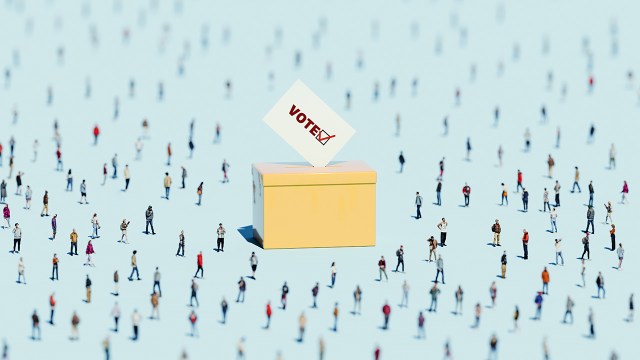
Confidence in U.S. public opinion polling was shaken by errors in 2016 and 2020. In both years’ general elections, many polls underestimated the strength of Republican candidates, including Donald Trump. These errors laid bare some real limitations of polling.
In the midterms that followed those elections, polling performed better . But many Americans remain skeptical that it can paint an accurate portrait of the public’s political preferences.
Restoring people’s confidence in polling is an important goal, because robust and independent public polling has a critical role to play in a democratic society. It gathers and publishes information about the well-being of the public and about citizens’ views on major issues. And it provides an important counterweight to people in power, or those seeking power, when they make claims about “what the people want.”
The challenges facing polling are undeniable. In addition to the longstanding issues of rising nonresponse and cost, summer 2024 brought extraordinary events that transformed the presidential race . The good news is that people with deep knowledge of polling are working hard to fix the problems exposed in 2016 and 2020, experimenting with more data sources and interview approaches than ever before. Still, polls are more useful to the public if people have realistic expectations about what surveys can do well – and what they cannot.
With that in mind, here are some key points to know about polling heading into this year’s presidential election.
Probability sampling (or “random sampling”). This refers to a polling method in which survey participants are recruited using random sampling from a database or list that includes nearly everyone in the population. The pollster selects the sample. The survey is not open for anyone who wants to sign up.
Online opt-in polling (or “nonprobability sampling”). These polls are recruited using a variety of methods that are sometimes referred to as “convenience sampling.” Respondents come from a variety of online sources such as ads on social media or search engines, websites offering rewards in exchange for survey participation, or self-enrollment. Unlike surveys with probability samples, people can volunteer to participate in opt-in surveys.
Nonresponse and nonresponse bias. Nonresponse is when someone sampled for a survey does not participate. Nonresponse bias occurs when the pattern of nonresponse leads to error in a poll estimate. For example, college graduates are more likely than those without a degree to participate in surveys, leading to the potential that the share of college graduates in the resulting sample will be too high.
Mode of interview. This refers to the format in which respondents are presented with and respond to survey questions. The most common modes are online, live telephone, text message and paper. Some polls use more than one mode.
Weighting. This is a statistical procedure pollsters perform to make their survey align with the broader population on key characteristics like age, race, etc. For example, if a survey has too many college graduates compared with their share in the population, people without a college degree are “weighted up” to match the proper share.
How are election polls being conducted?
Pollsters are making changes in response to the problems in previous elections. As a result, polling is different today than in 2016. Most U.S. polling organizations that conducted and publicly released national surveys in both 2016 and 2022 (61%) used methods in 2022 that differed from what they used in 2016 . And change has continued since 2022.
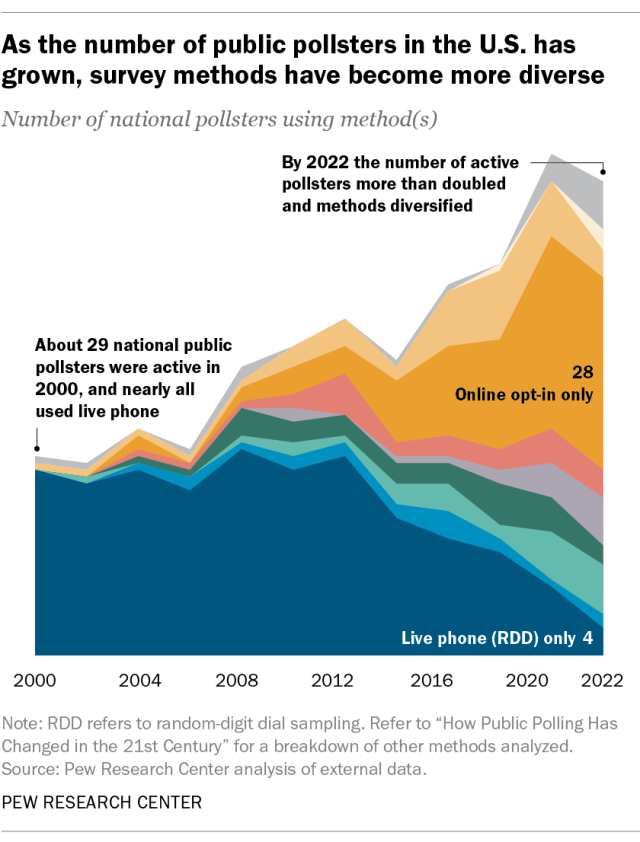
One change is that the number of active polling organizations has grown significantly, indicating that there are fewer barriers to entry into the polling field. The number of organizations that conduct national election polls more than doubled between 2000 and 2022.
This growth has been driven largely by pollsters using inexpensive opt-in sampling methods. But previous Pew Research Center analyses have demonstrated how surveys that use nonprobability sampling may have errors twice as large , on average, as those that use probability sampling.
The second change is that many of the more prominent polling organizations that use probability sampling – including Pew Research Center – have shifted from conducting polls primarily by telephone to using online methods, or some combination of online, mail and telephone. The result is that polling methodologies are far more diverse now than in the past.
(For more about how public opinion polling works, including a chapter on election polls, read our short online course on public opinion polling basics .)
All good polling relies on statistical adjustment called “weighting,” which makes sure that the survey sample aligns with the broader population on key characteristics. Historically, public opinion researchers have adjusted their data using a core set of demographic variables to correct imbalances between the survey sample and the population.
But there is a growing realization among survey researchers that weighting a poll on just a few variables like age, race and gender is insufficient for getting accurate results. Some groups of people – such as older adults and college graduates – are more likely to take surveys, which can lead to errors that are too sizable for a simple three- or four-variable adjustment to work well. Adjusting on more variables produces more accurate results, according to Center studies in 2016 and 2018 .
A number of pollsters have taken this lesson to heart. For example, recent high-quality polls by Gallup and The New York Times/Siena College adjusted on eight and 12 variables, respectively. Our own polls typically adjust on 12 variables . In a perfect world, it wouldn’t be necessary to have that much intervention by the pollster. But the real world of survey research is not perfect.
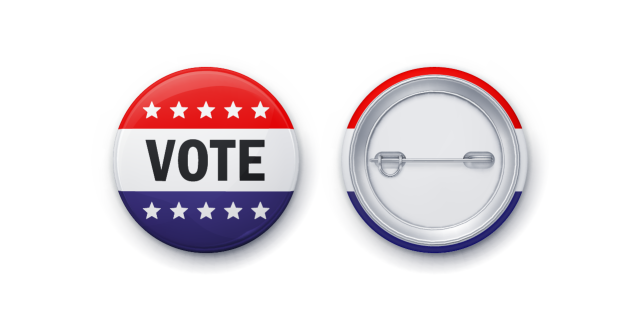
Predicting who will vote is critical – and difficult. Preelection polls face one crucial challenge that routine opinion polls do not: determining who of the people surveyed will actually cast a ballot.
Roughly a third of eligible Americans do not vote in presidential elections , despite the enormous attention paid to these contests. Determining who will abstain is difficult because people can’t perfectly predict their future behavior – and because many people feel social pressure to say they’ll vote even if it’s unlikely.
No one knows the profile of voters ahead of Election Day. We can’t know for sure whether young people will turn out in greater numbers than usual, or whether key racial or ethnic groups will do so. This means pollsters are left to make educated guesses about turnout, often using a mix of historical data and current measures of voting enthusiasm. This is very different from routine opinion polls, which mostly do not ask about people’s future intentions.
When major news breaks, a poll’s timing can matter. Public opinion on most issues is remarkably stable, so you don’t necessarily need a recent poll about an issue to get a sense of what people think about it. But dramatic events can and do change public opinion , especially when people are first learning about a new topic. For example, polls this summer saw notable changes in voter attitudes following Joe Biden’s withdrawal from the presidential race. Polls taken immediately after a major event may pick up a shift in public opinion, but those shifts are sometimes short-lived. Polls fielded weeks or months later are what allow us to see whether an event has had a long-term impact on the public’s psyche.
How accurate are polls?
The answer to this question depends on what you want polls to do. Polls are used for all kinds of purposes in addition to showing who’s ahead and who’s behind in a campaign. Fair or not, however, the accuracy of election polling is usually judged by how closely the polls matched the outcome of the election.
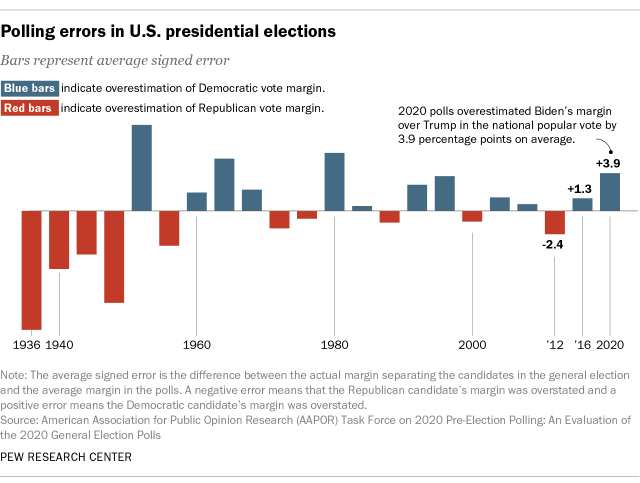
By this standard, polling in 2016 and 2020 performed poorly. In both years, state polling was characterized by serious errors. National polling did reasonably well in 2016 but faltered in 2020.
In 2020, a post-election review of polling by the American Association for Public Opinion Research (AAPOR) found that “the 2020 polls featured polling error of an unusual magnitude: It was the highest in 40 years for the national popular vote and the highest in at least 20 years for state-level estimates of the vote in presidential, senatorial, and gubernatorial contests.”
How big were the errors? Polls conducted in the last two weeks before the election suggested that Biden’s margin over Trump was nearly twice as large as it ended up being in the final national vote tally.
Errors of this size make it difficult to be confident about who is leading if the election is closely contested, as many U.S. elections are .
Pollsters are rightly working to improve the accuracy of their polls. But even an error of 4 or 5 percentage points isn’t too concerning if the purpose of the poll is to describe whether the public has favorable or unfavorable opinions about candidates , or to show which issues matter to which voters. And on questions that gauge where people stand on issues, we usually want to know broadly where the public stands. We don’t necessarily need to know the precise share of Americans who say, for example, that climate change is mostly caused by human activity. Even judged by its performance in recent elections, polling can still provide a faithful picture of public sentiment on the important issues of the day.
The 2022 midterms saw generally accurate polling, despite a wave of partisan polls predicting a broad Republican victory. In fact, FiveThirtyEight found that “polls were more accurate in 2022 than in any cycle since at least 1998, with almost no bias toward either party.” Moreover, a handful of contrarian polls that predicted a 2022 “red wave” largely washed out when the votes were tallied. In sum, if we focus on polling in the most recent national election, there’s plenty of reason to be encouraged.
Compared with other elections in the past 20 years, polls have been less accurate when Donald Trump is on the ballot. Preelection surveys suffered from large errors – especially at the state level – in 2016 and 2020, when Trump was standing for election. But they performed reasonably well in the 2018 and 2022 midterms, when he was not.
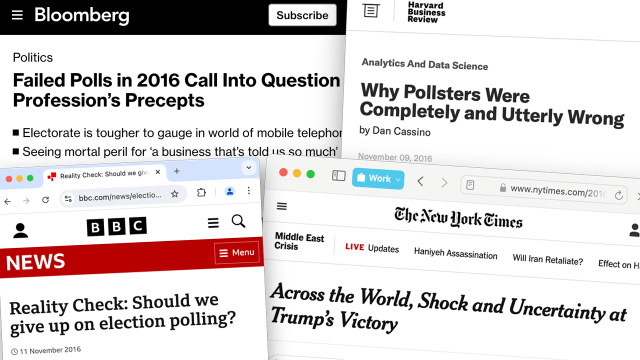
During the 2016 campaign, observers speculated about the possibility that Trump supporters might be less willing to express their support to a pollster – a phenomenon sometimes described as the “shy Trump effect.” But a committee of polling experts evaluated five different tests of the “shy Trump” theory and turned up little to no evidence for each one . Later, Pew Research Center and, in a separate test, a researcher from Yale also found little to no evidence in support of the claim.
Instead, two other explanations are more likely. One is about the difficulty of estimating who will turn out to vote. Research has found that Trump is popular among people who tend to sit out midterms but turn out for him in presidential election years. Since pollsters often use past turnout to predict who will vote, it can be difficult to anticipate when irregular voters will actually show up.
The other explanation is that Republicans in the Trump era have become a little less likely than Democrats to participate in polls . Pollsters call this “partisan nonresponse bias.” Surprisingly, polls historically have not shown any particular pattern of favoring one side or the other. The errors that favored Democratic candidates in the past eight years may be a result of the growth of political polarization, along with declining trust among conservatives in news organizations and other institutions that conduct polls.
Whatever the cause, the fact that Trump is again the nominee of the Republican Party means that pollsters must be especially careful to make sure all segments of the population are properly represented in surveys.
The real margin of error is often about double the one reported. A typical election poll sample of about 1,000 people has a margin of sampling error that’s about plus or minus 3 percentage points. That number expresses the uncertainty that results from taking a sample of the population rather than interviewing everyone . Random samples are likely to differ a little from the population just by chance, in the same way that the quality of your hand in a card game varies from one deal to the next.
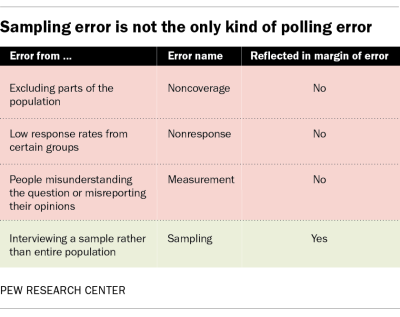
The problem is that sampling error is not the only kind of error that affects a poll. Those other kinds of error, in fact, can be as large or larger than sampling error. Consequently, the reported margin of error can lead people to think that polls are more accurate than they really are.
There are three other, equally important sources of error in polling: noncoverage error , where not all the target population has a chance of being sampled; nonresponse error, where certain groups of people may be less likely to participate; and measurement error, where people may not properly understand the questions or misreport their opinions. Not only does the margin of error fail to account for those other sources of potential error, putting a number only on sampling error implies to the public that other kinds of error do not exist.
Several recent studies show that the average total error in a poll estimate may be closer to twice as large as that implied by a typical margin of sampling error. This hidden error underscores the fact that polls may not be precise enough to call the winner in a close election.
Other important things to remember
Transparency in how a poll was conducted is associated with better accuracy . The polling industry has several platforms and initiatives aimed at promoting transparency in survey methodology. These include AAPOR’s transparency initiative and the Roper Center archive . Polling organizations that participate in these organizations have less error, on average, than those that don’t participate, an analysis by FiveThirtyEight found .
Participation in these transparency efforts does not guarantee that a poll is rigorous, but it is undoubtedly a positive signal. Transparency in polling means disclosing essential information, including the poll’s sponsor, the data collection firm, where and how participants were selected, modes of interview, field dates, sample size, question wording, and weighting procedures.
There is evidence that when the public is told that a candidate is extremely likely to win, some people may be less likely to vote . Following the 2016 election, many people wondered whether the pervasive forecasts that seemed to all but guarantee a Hillary Clinton victory – two modelers put her chances at 99% – led some would-be voters to conclude that the race was effectively over and that their vote would not make a difference. There is scientific research to back up that claim: A team of researchers found experimental evidence that when people have high confidence that one candidate will win, they are less likely to vote. This helps explain why some polling analysts say elections should be covered using traditional polling estimates and margins of error rather than speculative win probabilities (also known as “probabilistic forecasts”).
National polls tell us what the entire public thinks about the presidential candidates, but the outcome of the election is determined state by state in the Electoral College . The 2000 and 2016 presidential elections demonstrated a difficult truth: The candidate with the largest share of support among all voters in the United States sometimes loses the election. In those two elections, the national popular vote winners (Al Gore and Hillary Clinton) lost the election in the Electoral College (to George W. Bush and Donald Trump). In recent years, analysts have shown that Republican candidates do somewhat better in the Electoral College than in the popular vote because every state gets three electoral votes regardless of population – and many less-populated states are rural and more Republican.
For some, this raises the question: What is the use of national polls if they don’t tell us who is likely to win the presidency? In fact, national polls try to gauge the opinions of all Americans, regardless of whether they live in a battleground state like Pennsylvania, a reliably red state like Idaho or a reliably blue state like Rhode Island. In short, national polls tell us what the entire citizenry is thinking. Polls that focus only on the competitive states run the risk of giving too little attention to the needs and views of the vast majority of Americans who live in uncompetitive states – about 80%.
Fortunately, this is not how most pollsters view the world . As the noted political scientist Sidney Verba explained, “Surveys produce just what democracy is supposed to produce – equal representation of all citizens.”
- Survey Methods
- Trust, Facts & Democracy
- Voter Files

Scott Keeter is a senior survey advisor at Pew Research Center .

Courtney Kennedy is Vice President of Methods and Innovation at Pew Research Center .
How do people in the U.S. take Pew Research Center surveys, anyway?
How public polling has changed in the 21st century, what 2020’s election poll errors tell us about the accuracy of issue polling, a field guide to polling: election 2020 edition, methods 101: how is polling done around the world, most popular.
901 E St. NW, Suite 300 Washington, DC 20004 USA (+1) 202-419-4300 | Main (+1) 202-857-8562 | Fax (+1) 202-419-4372 | Media Inquiries
Research Topics
- Email Newsletters
ABOUT PEW RESEARCH CENTER Pew Research Center is a nonpartisan fact tank that informs the public about the issues, attitudes and trends shaping the world. It conducts public opinion polling, demographic research, media content analysis and other empirical social science research. Pew Research Center does not take policy positions. It is a subsidiary of The Pew Charitable Trusts .
© 2024 Pew Research Center

COMMENTS
Refereed paper to appear in Proceedings of the UniServe Science Annual Conference, Sydney, 2010. To achieve intellectual autonomy, university students should learn how to critically evaluate hypotheses and theories using evidence from the research literature. Typically this occurs in the context of writing an essay, or in planning the ...
Argumentative Writing and Using Evidence, Spring 2022. 4 of 5. Evidence: A study of New York middle schools found that by extending school lunches to all students, regardless of family income, test scores increased by 0.083 standard deviations in math and 0.059 in English Language Arts for non-poor students, and, though smaller, statistically ...
Statistics, data, charts, graphs, photographs, illustrations. Sometimes the best evidence for your argument is a hard fact or visual representation of a fact. This type of evidence can be a solid backbone for your argument, but you still need to create context for your reader and draw the connections you want them to make.
Evidence. The next step in the C-E-R writing framework is evidence. Evidence is the logic, proof, or support that you have for your claim. I mentioned earlier that your claim, while arguable, should be rooted in logic. Evidence is where you present the logic you used to arrive at your claim. Evidence seems easy, but students always struggle ...
When incorporating evidence into an essay, you need to make sure it flows well. Try using some of these key phrases in your essay to help you introduce your evidence: "The evidence clearly reveals…". "Analysis of the data suggests…". "This graph shows that…". "As shown by the information…". "This claim is supported by ...
o make it flow in a logical way. The main parts (or sections) to an essay are. the intro, body, and conclusion. In a standard short essay, five paragraphs can provide the reader with enough inform. tion in a short amount of space. For a research paper or dissertation, however, it is essential that more than five paragraphs are present in order ...
Use these ReadWriteThink resources to help students build their plans into a fully developed evidence based argument about text: Modeling Academic Writing Through Scholarly Article Presentations. And I Quote. Essay Map. Have students use the Evidence-Based Argument Checklist to revise and strengthen their writing.
Writing Prompt and Evidence ChartWrit. Select two of the texts we have read and write an essay including the following: Compare and contrast how information is presented in each text. from fact or interpretations Cite textual evid. The texts we chose are:
Make a claim. Provide the grounds (evidence) for the claim. Explain the warrant (how the grounds support the claim) Discuss possible rebuttals to the claim, identifying the limits of the argument and showing that you have considered alternative perspectives. The Toulmin model is a common approach in academic essays.
An essay outline is a way of planning the structure of your essay before you start writing. It involves writing quick summary sentences or phrases for every point you will cover in each paragraph, giving you a picture of how your argument will unfold. You'll sometimes be asked to submit an essay outline as a separate assignment before you ...
Basics of Using Evidence. One of the central features of scholarly writing is the use of evidence to make an argument. You must learn how to incorporate other scholars' writing and arguments into your own. In scholarly writing, you will often use paraphrased material or direct quotations from sources to support your research and strengthen your ...
Beyond introducing and integrating your paraphrases and quotations, you also need to analyze the evidence in your paragraphs. Analysis is your opportunity to contextualize and explain the evidence for your reader. Your analysis might tell the reader why the evidence is important, what it means, or how it connects to other ideas in your writing.
1. Find the Evidence Printables. To complete the text evidence printables, the students will read a grade level text (mix of fiction and nonfiction). They will then read to see what evidence they are looking for. They will reread the text, find required text evidence, and underline/highlight/or record it. 2.
Basic essay structure: the 3 main parts of an essay. Almost every single essay that's ever been written follows the same basic structure: Introduction. Body paragraphs. Conclusion. This structure has stood the test of time for one simple reason: It works. It clearly presents the writer's position, supports that position with relevant ...
Unit 1 - Claims, Reasoning, & Evidence. Unit 2 - Organizing Information for a Specific Audience. Unit 3 - Perspectives & How Arguments Relate. Unit 4 - How writers develop arguments, intros, & conclusions. Unit 5 - How a writer brings all parts of an argument together. Unit 6 - Position, Perspective, & Bias. Unit 7 - Successful ...
In this lesson, students continue their analysis of the article "The New Deal" to build their knowledge on this unit's informative writing topic. Students review the topic and claim of the article before briefly discussing how to organize their reading notes. Then, students work in pairs or groups to identify and chart the subtopics and ...
Exam Pro-Essay is a study aid that helps law students prepare to take their Evidence exam. Answering the sample essay exams and the specific subject matter essay questions, followed by review of the corresponding answers and analysis, provides students with a more thorough comprehension of the Federal Rules of Evidence and a better ...
Subjects tested on the Essay Portion of the Uniform Bar Exam. For the essay portion, you will have six questions to answer in three hours (so 30 minutes/question). the Uniform Bar Exam tests the same subjects that the Multistate Essay Exam (MEE) tests. (The Multistate Essay Exam is a six-question exam used by Uniform Bar Exam states as well as ...
Here is a big picture flowchart for analyzing whether evidence is admissible. First, has counsel asked a question? If so, apply Test # 1 to address whether there are any objections to the form of the question. Then, for all types of evidence, move on to Test #2 to address whether the proffered evidence is logically and legally relevant. In Test ...
Use this anchor chart with middle schoolers to make sure they're considering all sides of an argument, not just the one that matters the most to them. One way to adapt this chart as students develop their understanding of argument is to write each element—claim, argument, evidence—under a flap that students can lift if they need a reminder.
POW-TIDE is an acronym that can help you when you are writing a formal essay for class or for the writing assessment. If you use POW-TIDE, you will go through each step of the writing process ensuring that you are including everything you need for a POWerful essay!! P—Pull apart the prompt. O—Organize my thoughts. W—Write, write, write.
Mention unqualified and unreasonable sources as evidence. Accentuate the knowledge in an excessive manner. Dismiss alternative points of view and opposite opinions. Disinform or give distorted evidence. Be rude to the public or treat them like simpletons. So, remember that you should respect the audience every moment you are speaking with them.
Write a multi-paragraph essay with logical reasoning and relevant evidence that examines how both ideas are developed over the course of the text, demonstrating an understanding of the text. ... offer suggestions on a peer's writing, and publish the narrative essay. (W.7.6; L.7.1b; L.7.2a, b; L.7.3a; L.7.6) Use peer and teacher conferencing ...
As they read, they should think about the evidence they see in their poet's poems of what inspired him or her. Post and review the following directions: 1. As a group, use a search engine to find poems by your expert group poet. 2. As a group, select a poem to read. 3.
Average Weight of Primary School Children in Thirty-Three Urban Schools in Japan: 1937-1947, in Supplementary School Lunch Program, 1948 National Library of Medicine #101709949
There is evidence that when the public is told that a candidate is extremely likely to win, some people may be less likely to vote. Following the 2016 election, many people wondered whether the pervasive forecasts that seemed to all but guarantee a Hillary Clinton victory - two modelers put her chances at 99% - led some would-be voters to ...